lordroel
Administrator
Posts: 68,086 
Likes: 49,471
|
Post by lordroel on Aug 4, 2022 2:49:00 GMT
Day 1422 of World War II, August 4th 1943Eastern FrontSoviet forces captured Orel. Fresh attacks were launched by the Steppe and Voronezh Fronts south of Kursk targeted at the 4.Panzerarmee and 8.Armee. The lines of the 52nd Corps were broken in the initial attacks. Air War over Europe 5 Mosquitoes bombed the estimated positions of Cologne and Duisburg through cloud without loss. The US Eighth Air Force's VIII Air Support Command flew Mission 14. 33 B-26B Marauders bombed shipyards at Le Trait, France at 19:26 hours local without loss. Allied invasion of SicilyOperation 'Husky' Day 26: In Sicily, British forces were fighting in the Catania area. The British crossed the Salso River with 2 divisions, while other forces prepared to drive on Catania and others continued toward Misterbianco. Other American forces were halted by fierce opposition at the Furiano River and Troina. Photo: A Sherman tank moving at speed near Catania, 4 August 1943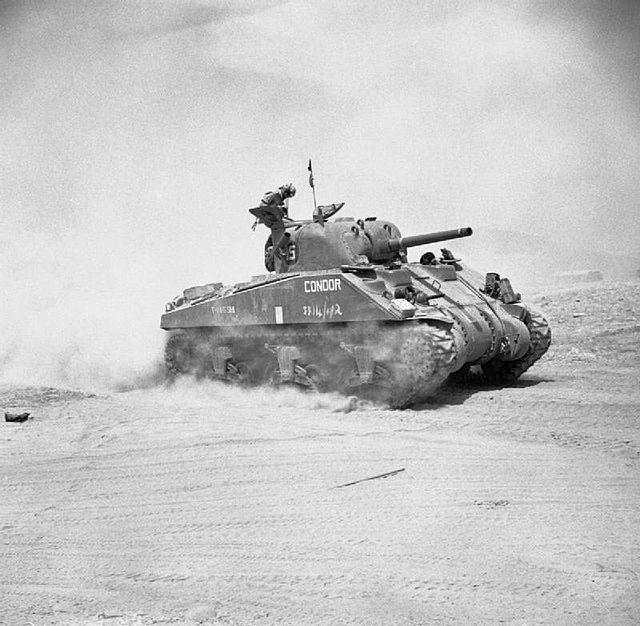 In the air, Ninth Air Force P-40s attacked shipping at Messina and supported ground forces at the north end of Mount Etna. Northwest African Tactical Air Force (NATAF) medium and light bombers, and fighters attacked communications targets, gun positions, and storage areas in the Milazzo-Adrano-Biancavilla and Bronte-Riposto-Fiumefreddo areas. A number of NATAF aircraft hit rail sidings on the toe of Italy and attacked shipping off Messina, Sicily. Battle of the AtlanticThe German submarine 'U-489' was sunk southeast of Iceland by an RCAF Sunderland Mk III, s/n DD859, of No 423 Squadron based at Castle Archdale, Northern Ireland. 53 of the 54 crewman on the U-boat survive. This supply U-boat had set out on its first patrol on 22 July, barely a fortnight before its sinking, and did not, consequently provide replenishment to any other U-boat. Battle of the MediterraneanIn Italy, Northwest African Strategic Air Force (NASAF) B-17s bombed the submarine base at Naples in what Rome called "the most barbarous and merciless" raid so far: 150 people were killed. B-26s and B-25s hit the railroad bridge at Cantanzaro and rail-road at Paola. Photo: US air raid of Naples on 4 August 1943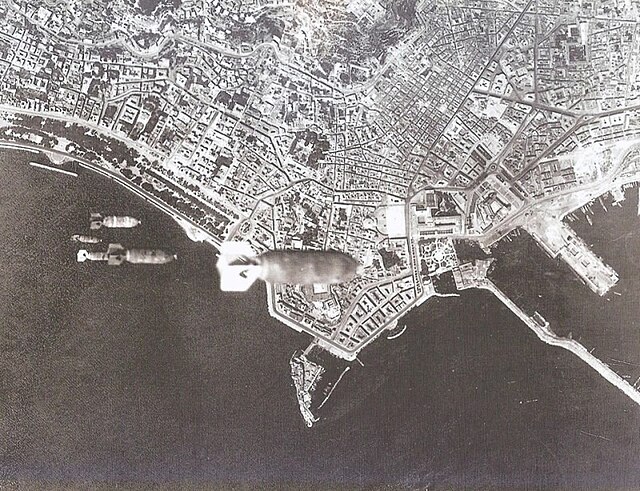 The Canadian-built, British-registered cargo ship 'Fort La Montee' (7,130 GRT) sank after a fire and explosion while in Algiers. 'Fort La Montee' was loaded with a cargo of phosphorous. As soon as the fire was discovered, the ship was moved out of the harbor due to her hazardous cargo. The Acasta-class fleet destroyer HMS 'Arrow' was standing by to render assistance when an enormous explosion destroyed the forward end of 'Fort La Montee'. Over 100 lives were lost in 'Fort La Montee' and 'Arrow'. A British submarine was eventually able to sink the after end of the freighter with gunfire. 'Arrow' was declared a Constructive Total Loss. Destroyer Shubrick (DD-639) is damaged by dive bomber off Palermo, Sicily, 38°06'N, 13°20'E. U.S. freighter Harrison Grey Otis, anchored in Gibraltar harbor, is irreparably damaged by Italian limpet mine. Of the ship's 45-man merchant complement, one man dies and eight are injured; there are no casualties among the 23-man Armed Guard. United StatesPhoto: The U.S. Navy light cruiser USS Nashville (CL-43) off the Mare Island Naval Shipyard, California (USA), on 4 August 1943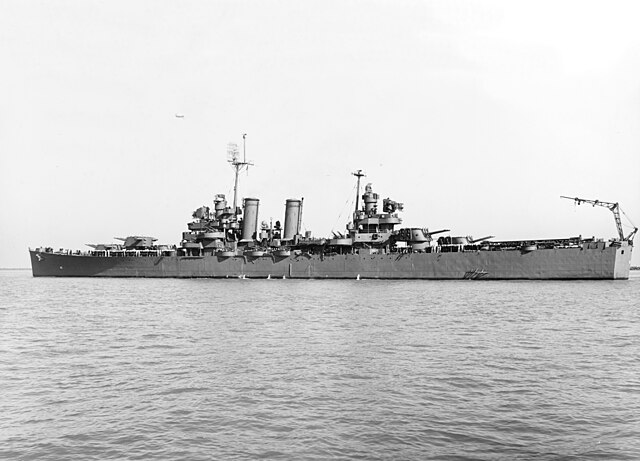 Photo: The U.S. Navy destroyer USS Charrette (DD-581) underway in Boston Harbor, Massachusetts (USA), on 4 August 1943 Photo: The U.S. Navy destroyer USS Charrette (DD-581) underway in Boston Harbor, Massachusetts (USA), on 4 August 1943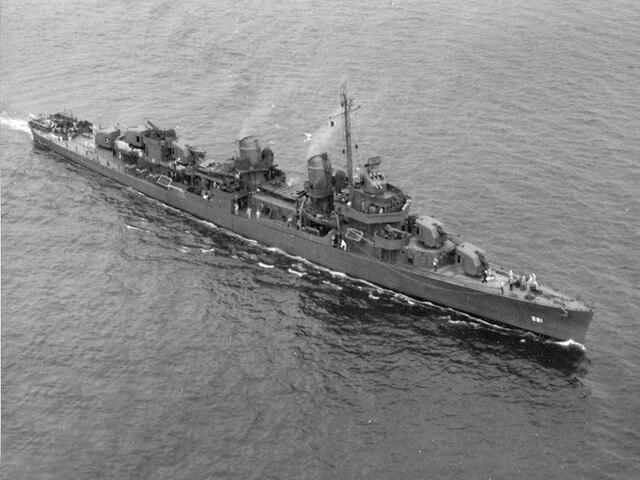 Photo: The U.S. Navy destroyer USS Trathen (DD-530) off the Mare Island Naval Shipyard on 4 August 1943. Trathen was in overhaul at the shipyard from 11 July to 4 August 1943 Photo: The U.S. Navy destroyer USS Trathen (DD-530) off the Mare Island Naval Shipyard on 4 August 1943. Trathen was in overhaul at the shipyard from 11 July to 4 August 1943 Photo: The U.S. Navy destroyer USS Franks (DD-554) underway in Smith Cove, Washington (USA), on 24 August 1943, speed 4 knots Photo: The U.S. Navy destroyer USS Franks (DD-554) underway in Smith Cove, Washington (USA), on 24 August 1943, speed 4 knots Pacific War Pacific WarALEUTIAN ISLANDS CAMPAIGN (Eleventh Air Force) In the Aleutian Islands, between 0855 and 1846 hours, 153 tons of bombs are dropped on Kiska Island, a new one-day record; 6 armored weather, photo and reconnaissance missions, flown by 3 B-24's, 2 P-40's, and 2 F-5A's bomb through clouds, take photos and observe fires in Main Camp and on Little Kiska Island; later 48 B-25's, 22 B-24's, 16 A-24s, 8 P-40's, and 40 P-38's fly 17 bombing and strafing attacks to Kiska Island; targets hit include buildings near the radio station, and the gun battery area on North Head. Little Kiska Island and Segula Island are also strafed.The 36th Bombardment Squadron (Heavy), 28th Composite Group, which has been operating from Adak Island with B-24's since Jun 43, returns to it's base on Amchitka Island. Photo: A-24 Banshee dive bombers from the 635th Bombardment Squadron, 407th Bombardment Group flying over the Aleutians carrying out an attack on Kiska Island on August 4, 1943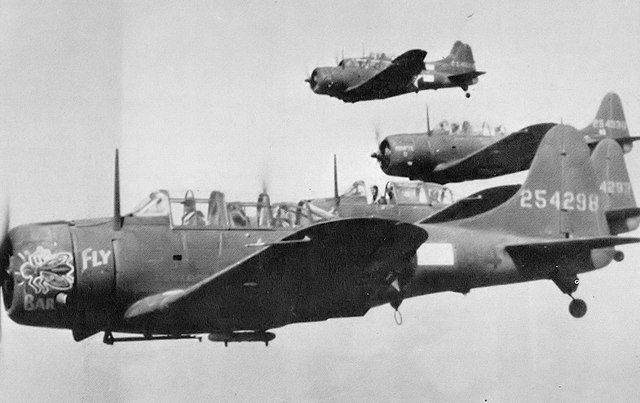 SOUTH PACIFIC THEATER OF OPERATIONS (Thirteenth Air Force): On New Georgia Island in the Solomons Island, B-25's, and US Navy dive bombers, bomb the Gurasai-Kindu Village area; some of the B-25's also strafe areas emitting intense small arms fire, silencing it. P-38's and P-40's claim 11 fighters downed in a series of running battles over the C Solomons. Photo: Siege and capture of Munda SOUTHWEST PACIFIC THEATER OF OPERATIONS (Fifth Air Force): B-25's bomb and strafe the Itni River area on New Britain Island and hit several villages on Selaroe Island in the Tanimbar Islands. Single B-24's bomb a dump area on the Francisco River, New Guinea and Cape Gloucester Airfield on New Britain Island. PACIFIC U.S. motor torpedo boats engage Japanese guardboats off Vanga Vanga, Kolombangara, sinking No. 3 Matsue Maru and driving Banyo Maru ashore, damaged. Submarine Finback (SS-230) sinks Japanese army cargo ship Kaisho Maru, 05°18'S, 111°50'E. Submarine Seadragon (SS-194) damages Japanese transport Kembu Maru, 07°33'N, 161°12'E.
|
|
lordroel
Administrator
Posts: 68,086 
Likes: 49,471
|
Post by lordroel on Aug 5, 2022 7:30:42 GMT
Day 1423 of World War II, August 5th 1943Eastern FrontBelgorod fell to General Konev's troops. The German 2.Panzerarmee suffered such severe losses that it was incorporated into the 9.Armee. Russia was celebrating the recapture of Orel, which had been in German hands since 1941. In Moscow a 120-gun salute was given at Midnight. The Russians, who fought hard all the way to the approaches to the city, expected a bloody street battle, but when their patrols moved cautiously in they found the suburbs deserted. The Germans, fearing being cut off, had fled. The fall of this German bastion removed the last threat to Moscow and opened the way for the next stage in the Russian advance. The tide of battle was now rolling towards Bryansk. Photo: Troops of the 89th Belgorod-Kharkov Guards Rifle Division on the streets of recently recaptured Belgorod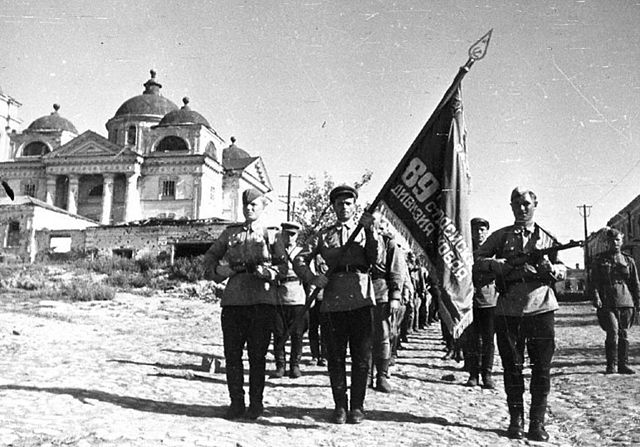 Air War over Europe Air War over Europe 5 Mosquitoes, out of 8 dispatched, bombed Duisburg and Dusseldorf without loss. Allied invasion of SicilyOperation 'Husky' Day 27: The race for Messina and victory in Sicily was reaching the final stage. The British have fought their way around Mount Etna on both sides with the Highlanders fighting hard for Biancavilla as the XIII Corps advanced to take Catania, Misterbianco and Paterno, and XXX Corps advances towards Adrano. The Germans were leaving strong rearguards as they retreated northwards to Messina. The British were aided by forward landings by airborne forces fighting to save bridges from demolition. Photo: Two soldiers from the Black Watch pass by a burning German anti-aircraft half-track, 5 August 1943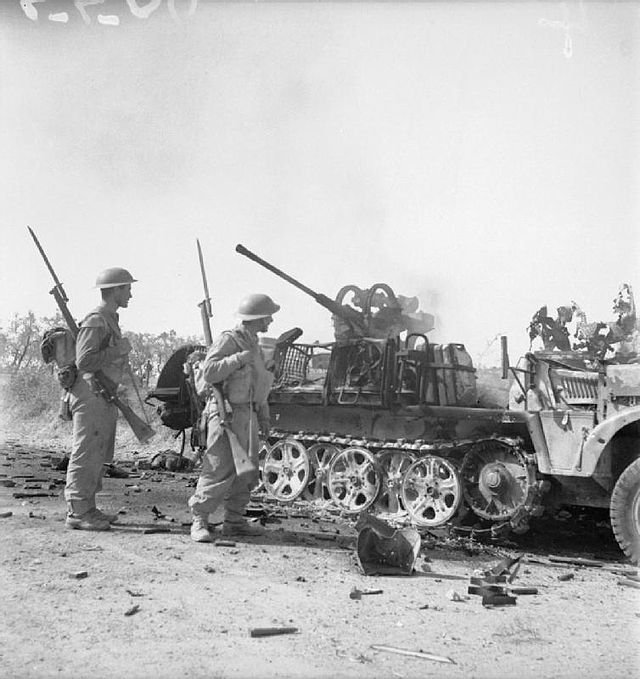 Photo: Infantry scramble over rubble in a devastated street in Catania, 5 August 1943 Photo: Infantry scramble over rubble in a devastated street in Catania, 5 August 1943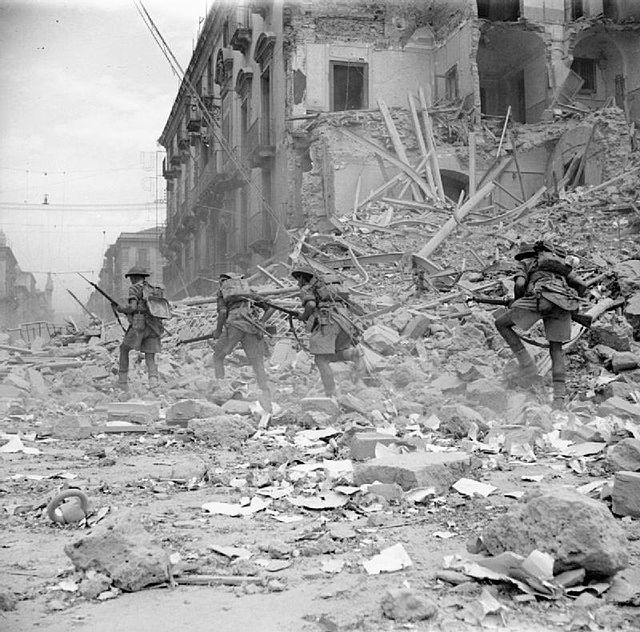 The American Seventh Army used seaborne landings to bypass the Axis defenders along the north coast of the island. They opened an assault on the San Fratello ridge, and further inland gained positions overlooking Troina. The enemy withdrew from the town during the night. In the air, USAAF Ninth Air Force B-25 Mitchells bombed the town, roads, and road junctions of Francavilla and shipping in the Straits of Messina. Northwest African Tactical Air Force fighters and light and medium bombers attack troops, roads, and gun positions at Adrano and Troina and surrounding areas in support of Allied ground forces, hit motor transport behind enemy lines in Sicily and on the toe of Italy, and sank or damaged over 20 small vessels and barges at Milazzo and in the Straits of Messina; and Northwest African Strategic Air Force B-17 Flying Fortresses, operating in 2 forces, hit the docks and railroad yards at Messina. B-25s bombed a switching station at Guspini, Sardinia. Battle of the Atlantic Destroyer Black (DD-666) is damaged when accidentally rammed by ferryboat Staten (YFB-36) at New York Navy Yard. Gunboat Plymouth (PG-57) is torpedoed and sunk by German submarine U-566, 120 miles southeast of Cape Henry, Virginia, 36°17'N, 74°29'W. Battle of the Baltic SeaThe German submarine 'U-34' sinks at 2155 hours local at Memel after a collision with the German U-boat submarine tender 'Lech'. 39 of the 43 crewmen survived. MV 'Majakovski' (approx. 80 tons) was sunk by a mine laid on 31 July by 'U-212' SE of Koglujew in the Kara. Swedish/German relationsIn a move which betrayed Germany's weakened position, the Swedish government announced that it would no longer allow the Swedish railways to be used to transport German troops and war material to Norway. The Swedes were forced to concede transit rights to the Germans in 1940 when the Nazi armies were sweeping to victory over most of Europe. Stockholm newspapers said that the government acted because a virtual state of war exists in Norway, with British commandos mounting raids and uniformed Allied guerrillas active. IrelandA Fairey Barracuda II of RAF No. 810 Squadron flying from HMS 'Illustrious', landed on the beach at Falcarragh, County Donegal. Due to bad weather the aircraft did not fly out until August 8th. RAF No.810 Squadron were at this time sailing to the Mediterranean on HMS 'Illustrious'. Irish Army reports mentioned the aircraft being a Beaufort bomber but this was not operated by the RN at this time. Pacific WarNEW GEORGIA In the Solomon Islands, U.S. Army ground forces capture Munda Airfield on New Georgia Island. SOUTH PACIFIC THEATER OF OPERATIONS (Thirteenth Air Force): B-24's bomb the shore of Rekata Bay W of the Borokeiello Point area. B-25's and US Navy fighters strafe barges on the NE coast of Gizo. The principal objective of C Solomons campaign: Munda Airfield is taken by XIV Corps forces after 12 continuous days of fierce fighting in the jungle area. The 372d Bombardment Squadron, 307th BG (Heavy), based on Espiritu Santo Island, New Hebrides Islands, begins operating from Guadalcanal Island in the Solomon Islands with B-24's. The squadron will fly it's first mission on Saturday. SOUTHWEST PACIFIC THEATER OF OPERATIONS (Fifth Air Force): 30+ B-25's pound barges near Madang and at Alexishafen. Lost is B-25D 41-30118 Also they hit the Nuru River bridge and towns of Bogadjim and Saidor; a single B-24 bombs Finschhafen while another hits Vitu Island in the Bismarck Archipelago. Lieutenant Colonel Malcolm A Moore takes command of the newly formed Second Air Task Force based at the recently constructed advance airfield at Tsili Tsili, New Guinea; strikes from here will facilitate operations against Lae, New Guinea. SOLOMON ISLANDS Photo: The U.S. Navy destroyer USS Selfridge (DD-357) in the Solomon Islands, 5 August 1943. Note the floating drydock at left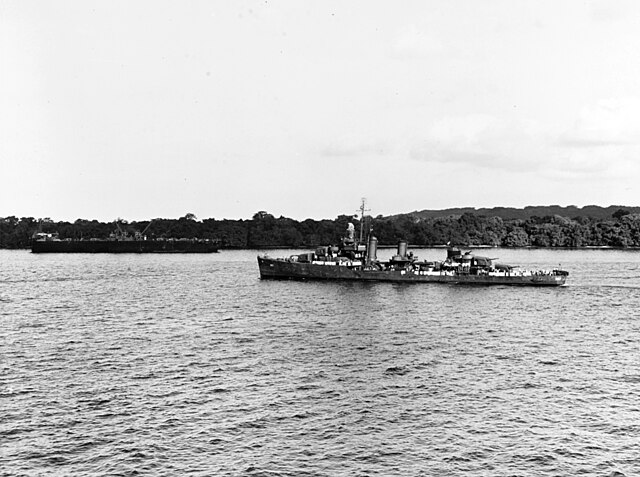 PACIFIC Submarine Pike (SS-173) sinks Japanese transport Shoju Maru west of Marcus Island, 24°30'N, 158°50'E. Submarine Silversides (SS-236) damages Japanese minelayer Tsugaru north-northeast of Rabaul, 01°53'N, 153°52'E. USAAF B-24 and USN/USMC F4Us sink Japanese fishing boat No.9 Kaiyo Maru off Kolombangara.
|
|
lordroel
Administrator
Posts: 68,086 
Likes: 49,471
|
Post by lordroel on Aug 6, 2022 13:55:10 GMT
Day 1424 of World War II, August 6th 1943YouTube (Allied Tidal Wave in Romania)Eastern FrontKonev’s forces drive to the outskirts of Kharkov taking Zolochev. Air War over Europe 8 Mosquitoes went to Cologne and Duisburg. 20 Stirlings and 14 Wellingtons went minelaying south of Texel and off Brest and the Biscay ports, 2 Stirlings lost. German civil defense officials ordered the partial evacuation of Berlin, fearing that that city would become the next Hamburg. Allied invasion of SicilyOperation 'Husky' Day 28: The US 1st Infantry Division captured Tronia after heavy fighting. The "Big Red One" had a bitter, tough fight. They then pushed through the town and one mile (1.6 km) to the east before opposition halted them. The British were advancing on Adrana. They also took Biancavilla. During the night they took Adrano as the enemy pulled back. Photo: 4.2-inch mortar of 1st Princess Louise's Kensington Regiment in action near Adrano, 6 August 1943 In the air, 60+ USAAF Ninth Air Force B-26 Marauders bombed Bronte, Catania, and Randazzo and the area north of the Adrano-Biancavilla road; 20+ others bombed road intersections in Adrano and Bronte; and 100+ P-40s attacked shipping and shore targets in the Messina area while 30 others attacked shipping on the west coast. Northwest African Strategic Air Force B-17 Flying Fortresses bombed coastal roads near Messina; B-26s and B-25 Mitchells hit a road junction southwest of Badiazza and railroad bridges north of Gesso. Northwest African Tactical Air Force light and medium bombers hit roads, junctions, and buildings in the Troina, Adrano, Biancavilla, Tortorici, Bronte, Piranino, and Randazzo areas and the Bagnara, Italy area; and fighter-bombers hit shipping from Vibo Valentia south to the Straits of Messina. Battle of the Atlantic At 0450 hours, the unescorted 'Fort Halkett' was torpedoed and sunk by gunfire by 'U-185' about 600 miles SE of Natal, Brazil. The master and 23 survivors landed south of Natal. The chief officer and 23 survivors were picked up by destroyer USS 'Goldsborough' and landed at Recife. The second officer and ten survivors landed at Cabadello, Brazil. 'U-615' was sunk by USN Mariner aircraft, Squadron VP-205/P-4. The boat was lost in a massive hunt in the Caribbean. It fought bravely for days against overwhelming odds before finally being sunk. Battle of the Mediterranean Tank landing ships LST-3 is damaged by horizontal bomber off Sicily, 38°01'N, 14°20'E. Italy At Tarvisio, Italy, the new Italian government met with German Foreign Minister Ribbentrop and assured him that they would not be negotiating a separate peace with the Allies. But German troops started pouring in to take over the country's defences. North Africa Luftwaffe bomber operations over North Africa in the weeks prior to the expected Allied landings on mainland Italy included a raid on Bizerta during the night. United KingdomPhoto: HMS Pretoria Castle at anchor Pacific War Pacific WarSOUTH PACIFIC THEATER OF OPERATIONS (Thirteenth Air Force): 20 P-39's and P-40's hit the Tanagaba Harbor area; and 24 B-17's and B-24's, 24 B-25's, and 50+ US Navy and USMC fighters and dive bombers pound the Rekata Bay area, hitting bivouac and supply areas. A F5A photo recon lightning, escorted bvy eight F4Us from VMF-221 on Banika preform an armed reconnassiance flying 50-100 feet off the water against the seaplane base at Shortland Harbor. They suprise enemy Rufe and Jake seaplanes taking off, but are attacked by about a dozen A6M Zeros in the air, probably from Ballale patroling overhead. They shoot down five enemy planes. Two F4Us are damaged, one piloted by Bill Blakeslee goes MIA. The 63d Troop Carrier Squadron, 403d Troop Carrier Group, arrives on Espiritu Santo Island, New Hebrides Islands from the US with C-47's. The squadron begins flying missions upon arrival. NEW GEORGIA CAMPAIGN - BATTLE OF VELLA GULF Japanese installations on Santa Isabel Island are attacked: 20 USAAF P-39 Airacobras and P-40s hit the Tanagaba Harbor area; and 24 USAAF B-17s and B-24 Liberators and 24 B-25s, join 50+ USN and USMC F4U Corsairs and SBD Dauntlesses which the Rekata Bay area, hitting bivouac and supply areas. Shortly before 2400 hours local, the Battle of Vella Gulf is joined as six destroyers of the USN's Task Group 36.2 (Commander Frederick Moosbrugger) attack four Japanese destroyers attempting to bring troops and supplies to Kolombangara Island in Vella Gulf; USN destroyers USS Dunlap, USS Craven, and USS Maury sink IJN destroyers Kawakaze, Hagikaze, and Arashi, at position 07.50S, 156.47E. U.S. forces suffers no damage. SOUTHWEST PACIFIC THEATER OF OPERATIONS (Fifth Air Force): During the night of 6/7 Aug, B-24's bomb Laha Airfield on Amboina Island. PACIFIC Submarine Pike (SS-173) unsuccessfully attacks Japanese aircraft carrier Taiyo, 21°03'N, 153°31'E.
|
|
lordroel
Administrator
Posts: 68,086 
Likes: 49,471
|
Post by lordroel on Aug 7, 2022 6:27:33 GMT
Day 1425 of World War II, August 7th 1943Air War over Europe 4 Mosquitoes bombed Cologne and 1 bombed Dusseldorf without loss. Allied invasion of SicilyOperation 'Husky' Day 29: British forces made good progress on Sicily, capturing Adrana and advancing toward Bronte. U.S. forces improved their positions on the north coast in the San Fratello region against heavy resistance. During the night, a small amphibious force landed on the coast 2 miles (3.2 km) east of Sant' Agata di Militello, greatly aiding progress along the coast. Other forces began a drive on Randazzo. Photo: Men of the 9th Durham Light Infantry take cover on a street corner in Acireale, 8 August 1943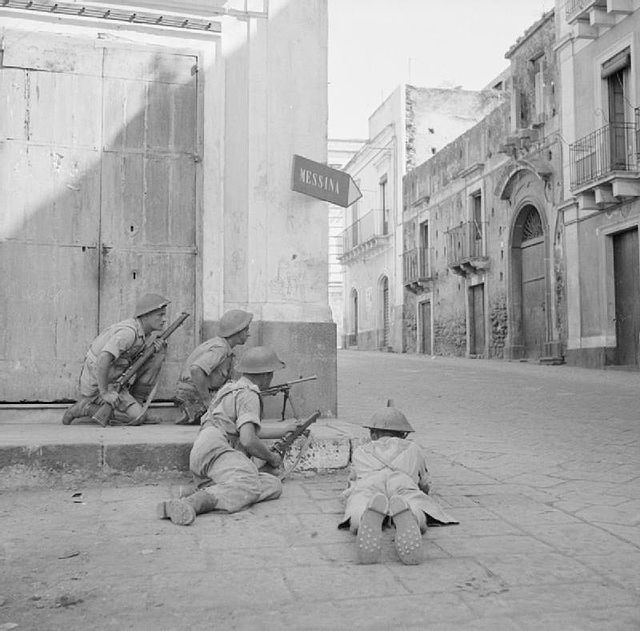 In the air, 150 USAAF Ninth Air Force B-25 Mitchells attacked Randazzo and 140+ P-40s attacked shipping at Messina and in the Straits, and shipping and shore-supply stores along the northeastern coast. Northwest African Tactical Bomber Force medium and light bombers pounded Randazzo, the enemy's key withdrawal point. Maletto was also bombed. P-40s and A-36 Apaches strafed and bombed small craft between Sicily and mainland Italy, motor transport near Randazzo, a warehouse north of Messina, dumps on the toe of Italy, and vehicles and communications targets in the Sant' Agata di Militello, Bronte, Cesaro, Tortorici, Castiglione di Sicilia and Riposto areas. Northwest African Strategic Air Force B-25s in 2 forces hit the landing ground at Crotone while B-26 Marauders bombed the railroad bridge at Marina di Cantanzaro and highway bridge over the Angitola River. Battle of the Atlantic Two German U-boats were sunk by US aircraft. 'U-117' was sunk west of the Azores, while supplying 'U-66', by depth charges and a Fido homing torpedo from five USN TBF Avengers of Composite Squadron One (VC-1) in the escort aircraft carrier USS 'Card' (CVE-11). All hands, 62 men, on the U-boat were lost. Battle of the MediterraneanIn response to urgent political orders, 197 Lancasters of 1, 5 and 8 Groups were dispatched to attack Genoa, Milan and Turin. It is believed that every aircraft reached the target area. 195 crews returned and reported bombing. 2 aircraft were lost, one was LM339 from 61 Sqdn crewed by F/O E. Filmer, P/O H. Halkier, F/Sgt E.R. Smart, Sgt D. Brown, Sgt C.P. Southcott, Sgt D.W. Thirsk and Sgt F.E. West. Group Captain J.H. Searby of RAF No.83 Sqdn acted as Master Bomber for the bombing at Turin but with only limited success. This was a trial in preparation for the role he would play in the raid on Peenemunde later in the month. The only report available from Italy says that 20 people were killed and 79 were injured in Turin. The 'Contractor' (Master Andrew Brims) in convoy GTX-5 was torpedoed and sunk by 'U-371' about 75 miles southwest of Sardinia. The master and three crew members were lost. 68 crew members and eleven gunners were picked up by HMS BYMS-2011 (J 811) (Lt L. Hutchinson), HMS BYMS-2014 (J 814) (SubLt R.R. Macintosh), HMS BYMS-2024 (J 824) (Skipper J. Hunt) and HMS BYMS-2209 (J 1009) (Lt J.G. Reeve) and landed at Malta. 'U-566' shot down two PV-1 Ventura aircraft from VB-128. Battle of the Caribbean 'U-615' was attacked southeast of Curacao Island, Netherlands Antilles, on 6 August by a PBM-3S Mariner of Patrol Squadron Two Hundred Five (VP-205), based at NAS Guantanamo Bay, Cuba. The submarine was on the surface and returned fire shooting down the aircraft with the loss of all hands. A PBM-3C of VP-204, based at NS San Juan, Puerto Rico, then attacked causing moderate damage and forcing the submarine to dive. For the rest of the day and during the night, VP-204 flew continuous patrols over the area forcing the submarine to remain submerged. In the morning, 'U-615' surfaced and a VP-204 aircraft attacked but was shot down with the loss of all hands. A second PBM attacked and caused moderate damage to both the sub and the aircraft but the PBM remained in the area until a USN PV-1 Ventura of Bombing Squadron One Hundred Thirty (VB-130), based at Edinburgh Field, Trinidad, arrived and both aircraft conducted a coordinated bombing and strafing attack sinking the sub. 43 of the 47 crewman survived and were picked up by a US destroyer the next morning. This was possibly the longest ongoing combat between a U-boat and aircraft. 'U-615's' battle enabled many other U-boats in the Caribbean to surface and escape to the east. The aircraft were from the following squadrons; VP-204 (P-6 and P-8), VP-205 (P-2, P-11 and P-4) and VB-130 (Ventura B-5). The 'Fernhill' (Master K.J. Neuberth Wie) was hit by one torpedo from 'U-757' about 300 miles west of Sierra Leone, while she was proceeding alone after her convoy OS-52 had been dispersed off Bathurst, Gambia. The ship sank within five minutes, killing the three men on watch below and one British gunner. The survivors abandoned ship in lifeboats and rafts and were picked up two days later by an American merchant and taken to Freetown. The third engineer Nils Bremer Johannesen was taken prisoner by the U-boat, this was not noticed by the other survivors. Battle of the Indian Ocean The 'Umvuma' (Master John Newby Gibson), dispersed from convoy DN-54, was torpedoed and sunk by 'U-181' southwest of Port Louis, Mauritius. 17 crew members, one gunner and four passengers were lost. The master, 72 crew members, eight gunners and eight passengers were picked up by the salvage tug 'Maurice' and landed at Port Louis. United StatesPhoto: The U.S. Navy destroyer USS Hoel (DD-533) underway in San Francisco Bay, California (USA), on 7 August 1943. The city of San Francisco and the Bay Bridge are in the background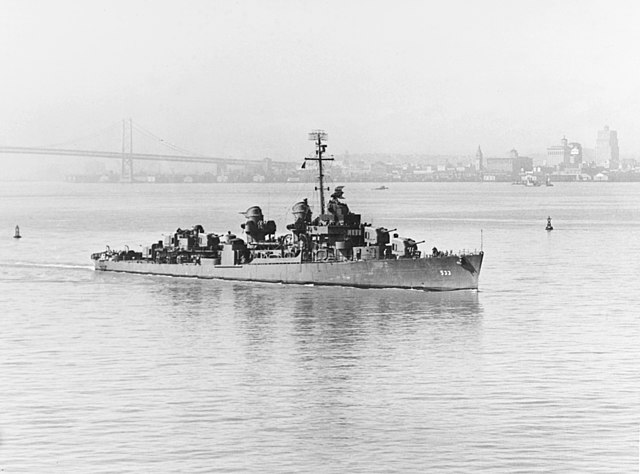 Photo: Launch of the U.S. Navy destroyer USS Wadleigh (DD-689) at the Bath Iron Works shipyard, Bath, Maine (USA), on 7 August 1943 Photo: Launch of the U.S. Navy destroyer USS Wadleigh (DD-689) at the Bath Iron Works shipyard, Bath, Maine (USA), on 7 August 1943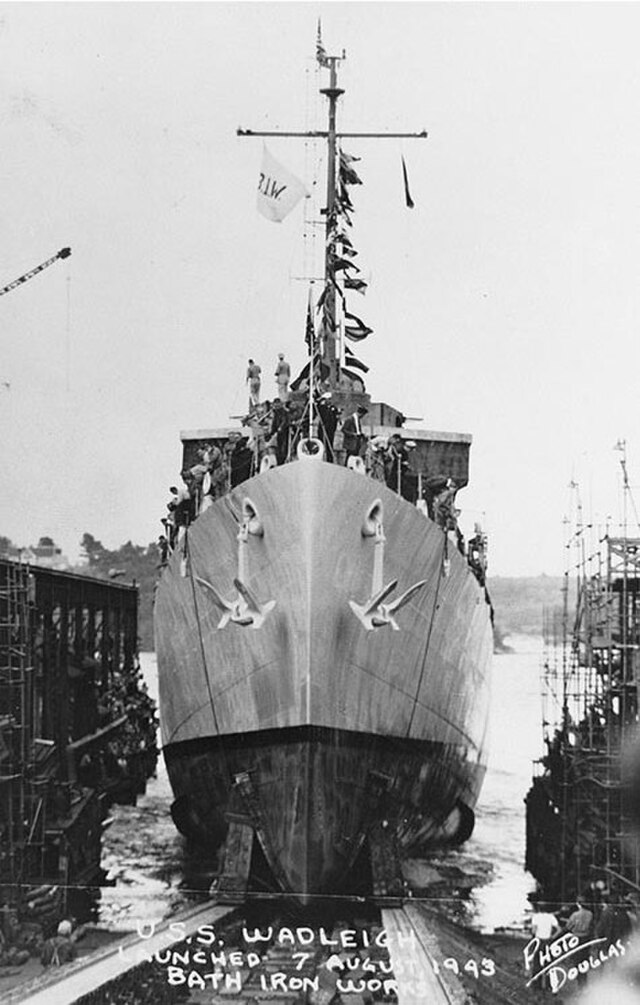 Photo: The U.S. Navy destroyer USS Hoel (DD-533) underway in San Francisco Bay, California (USA), on 7 August 1943 Photo: The U.S. Navy destroyer USS Hoel (DD-533) underway in San Francisco Bay, California (USA), on 7 August 1943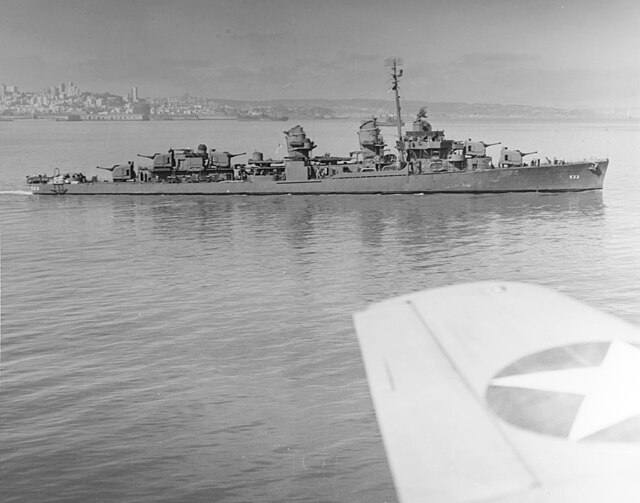 Pacific War Pacific WarSOUTH PACIFIC THEATER OF OPERATIONS (Thirteenth Air Force): 16 B-24's and 40+ B-25's, plus nearly 30 US Navy airplanes, pound the harbor and shore areas of Bairoko. The 64th Troop Carrier Squadron, 403d Troop Carrier Group, transfers with C-47's from Tontouta, New Caledonia to Espiritu Santo Island, New Hebrides Islands. SOUTHWEST PACIFIC THEATER OF OPERATIONS (Fifth Air Force): B-24's thoroughly pound the Salamaua area and also hit Kela Village. On Timor Island, B-25's hit Cape Chater Airfield and Lautem. Lost on a flight from Townsville to Brisbane is C-47 41-7733 with 27 crew and passengers died in this crash. Lost on a flight to Brisbane is C-47 41-7733. PACIFIC German auxiliary cruiser Michel (Schiffe 28) again sights transport Hermitage (AP-54) off Pitcairn Island, but, again, does not attack. Photo: The U.S. Navy light cruiser USS Honolulu (CL-48) underway near Espiritu Santo, New Hebrides, on 7 August 1943, en route to Pearl Harbor for battle damage repairs. She has been fitted with a short false bow as a temporary replacement for that lost in the Battle of Kolombangara, 13 July 1943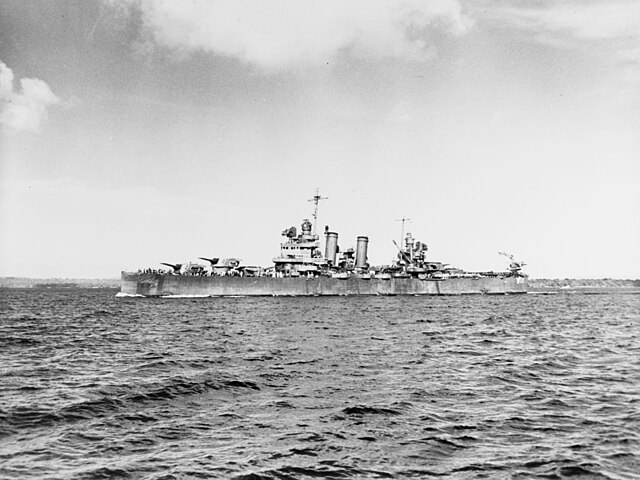 Photo: The U.S. Navy escort carrier USS Prince William (CVE-31) at sea, while transporting aircraft on 7 August 1943. She carries twelve Douglas SBD Dauntless, two Curtiss SOC Seagull, a Vought OS2U Kinflisher and two partially a dismantled planes, a Douglas R4D and a Grumman J2F Duck" Photo: The U.S. Navy escort carrier USS Prince William (CVE-31) at sea, while transporting aircraft on 7 August 1943. She carries twelve Douglas SBD Dauntless, two Curtiss SOC Seagull, a Vought OS2U Kinflisher and two partially a dismantled planes, a Douglas R4D and a Grumman J2F Duck" 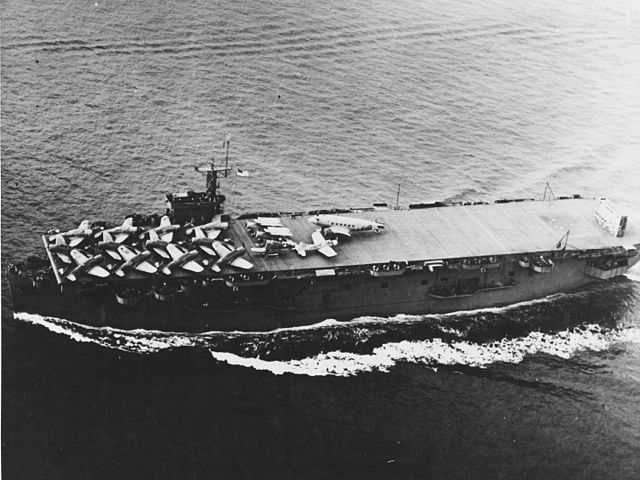
|
|
lordroel
Administrator
Posts: 68,086 
Likes: 49,471
|
Post by lordroel on Aug 8, 2022 2:55:25 GMT
Day 1426 of World War II, August 8th 1943
Air War over Europe
The USAAF's VIII Air Support Command in England flew Mission 15: 36 B-26B Marauders were dispatched to Nord Airfield at Poix, France but the formation was turned back by weather.
Allied invasion of Sicily
Operation 'Husky' Day 30: Patton launched an “end run” on Sicily by landing a small amphibious force east of Sant Agata. This move surprised the Germans and they were forced to make a hasty withdrawal allowing the 7th Army forces to take Cesaro. To the east, British forces took Bronte and Acireale. Militello and Monte Camolato were also captured. 130+ P-40s hit shipping at Messina and provided ground support in NE Sicily as US and British forces pushed east and north. Northwest African Tactical Air Force (NATAF) light and medium bombers pounded Randazzo. Fighters hit road targets north of Etna, shipping in the Straits of Messina, and covered ground forces at Sant' Agata di Militello.
Feldmarschall Albert Kesselring ordered the evacuation of Sicily, code-named 'Unternehman Lehrgang', which had been under preparation since shortly after the fall of Mussolini. Kesselring did this without consulting Hitler, who entered no objection when word reached him the next day. Fearing that Allied landings might cut off the escape routes to Messina, the German Commander in Sicily, General Hans-Valentin Hube, had already begun evacuating the wounded and able-bodied men who could be spared from the rearguard fighting.
Battle of the Atlantic
In the morning 'U-262' was awaiting refueling from 'U-664' while 'U-760' was being supplied in bad weather. At 10.11 hours, an Avenger/Wildcat team from USS 'Card' located the boats and attacked 'U-262'. The Wildcat (VC-1 USN, pilot Ens J.F. Sprague) strafed her while the Avenger (VC-1 USN, pilot Lt(jg) A.H. Sallenger) tried to attack with depth charges, but an AA hit in the bomb bay caused the ordnance to hung up and put the radio out of commission. Making a second run, the Avenger was hit again by AA fire and a fuel tank in the starboard wing caught fire. The two manually dropped depth charges severely damaged 'U-262', but the pilot had to jettison the Fido homing torpedo and ditched the burning aircraft. The radioman went down with the Avenger, while the pilot and the gunner were picked up in the afternoon by USS 'Barry' after being spotted by other aircraft from the escort carrier. The Wildcat was also shot down by the boat during another strafing run and crashed into the sea, killing its pilot. 'U-262' had to abort her patrol due to the damages. 'U-664' meanwhile, found the unalert escort-carrier USS 'Card' in a darkness and attacked her with 3 torpedoes before the Americans noticed him and drove him under and attacked with depth charges causing no damages.
A Beaufighter Ic belonging to RAF 2OTU Coastal Command crashed into the North Sea killing both crew members.
Battle of the Mediterranean
A week-long Allied bombing campaign against northern Italy commences. B-26s hit highway and rail bridges at Angitola, Italy, while P-38s strafed trains and other targets of opportunity SW of the town.
Mussolini was imprisoned on Maddalena Island, off northeast coast of Sardinia.
Pacific War
SOUTH PACIFIC THEATER OF OPERATIONS
(Thirteenth Air Force): On Kolombangara 23 B-25's, with P-38's, P-39's, and US Navy F4U's as cover, bomb Vila and Buki harbor. The 72d Bombardment Squadron (Heavy), 5th Bombardment Group (Heavy), which has been operating from Guadalcanal Island with B-17's since Oct 42, ceases combat operations and regroups at it's base on Espiritu Santo Island
in the New Hebrides Islands. The squadron will transition to B-24D's and re-enter combat in Oct 43.
SOUTHWEST PACIFIC THEATER OF OPERATIONS
(Fifth Air Force): B-24's attack Larat, shipping at Semboh, and barges at Kokas. Lost is B-24D "Big Emma" 41-23751. The 431st Fighter Squadron, 475th Fighter Group, based at Amberley Field, 25 miles (40 km) W of Brisbane, Queensland, Australia begins operating from Port Moresby, New Guinea with P-38's. The squadron will fly it's first mission on Thursday.
PACIFIC
Motor torpedo boat PT-113, damaged by grounding, eastern New Guinea, 09°12'S, 146°29'E, is beached and abandoned.
Submarine Salmon (SS-182) unsuccessfully attacks Japanese vessel Shinko Maru, 46°50'N, 144°40'E.
Submarine Whale (SS-239) sinks Japanese ammunition ship Naruto Maru northwest of the Marianas, 24°12'N, 142°52'E, and survives counterattack by destroyer Asanagi.
|
|
lordroel
Administrator
Posts: 68,086 
Likes: 49,471
|
Post by lordroel on Aug 9, 2022 2:48:06 GMT
Day 1427 of World War II, August 9th 1943Air War over Europe The USAAF VIII Air Support Command Missions 16A and 16B. 72 B-26B Marauders were dispatched to the Ft Rouge Airfield at St Omer, France. Clouds prevented bombing and only 1 aircraft hit the target at 1904 hours. 286 Lancasters and 171 Halifaxes attacked Mannheim. 6 Halifaxes and 3 Lancasters were lost, including Lancaster W4236 QR-K of 61 Sqdn with part of the crew, Sgt N.T. Holmes, Sgt J. Kendall and Sgt G. Spriggs. The target area was mainly cloud covered and the Pathfinder plan did not work well. The resulting bombing appeared to be scattered. Mannheim, whose wartime officials must have produced some of the best air raid reports in Germany, sent 37 typed pages of details which showed that this raid caused considerably damage in and around the city. 1,316 buildings were classed as "totally destroyed" or "seriously damaged". 42 industrial concerns, some of them being quite large ones, suffered loss of production. The compensation claims for 9 of the factories totalled 43,815,000 Reichsmarks(£4,381,500). 269 people were killed and 1,210 were injured. There were 1,528 fires: 133 large, 417 medium-sized and 978 small fires. 8 ralway engines, 146 passenger carriages and 40 goods wagons were damaged. 144 farm animals were killed: 96 pigs, 18 goats, 15 cows, 12 horses, 2 oxen and a calf. It is a measure of the increased striking power of Bomber Command that all of the damage and casualties quoted above was caused by a medium-sized raid which is described in the Bomber Command Record Book as a 'scattered attack'. 6 Mosquitoes went to Duisburg and 10 Stirlings minelaying in the Frisians without loss. Allied invasion of SicilyOn the ground in Sicily, US troops reached Torrenuovo, and, to the south, drove the enemy back to the Simeto River between Cesaro and Randazzo. Photo: Universal carriers of 2nd Wiltshire Regiment pass through Pedara, 9 August 1943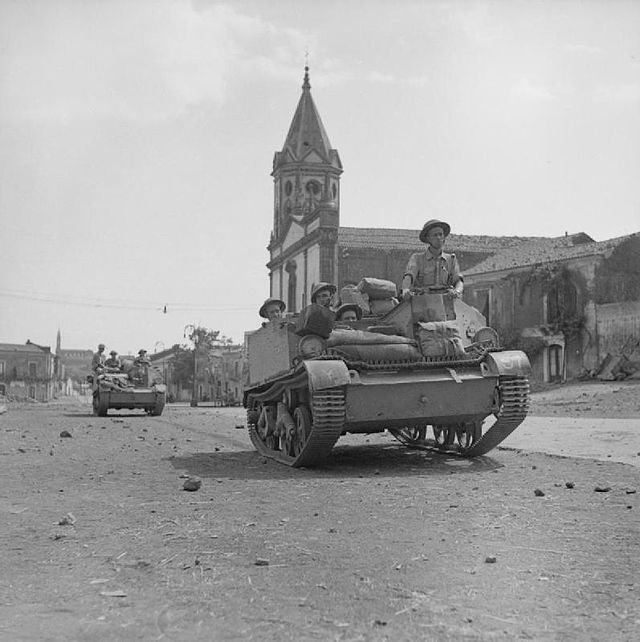 Photo: A Sherman tank passes through Trescatagni, 9 August 1943 Photo: A Sherman tank passes through Trescatagni, 9 August 1943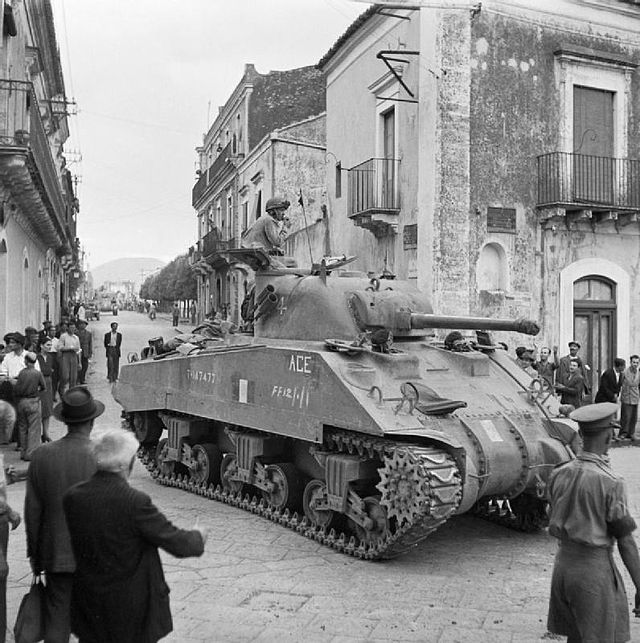 In Sicily, B-25s hit Divieto and a nearby tunnel W of Spadafora San Martino, and attacked special points in the battle area of NE Sicily. P-40s hit shipping at Messina, Milazzo, and Palmi. NASAF B-17s bombed crossroads north of Messina, Sicily. NATAF bombers hit the Gesso road junction; fighters concentrated on highways and junctions and also hit all sidings and gun positions in areas around Linguaglossa, Floresta, Falcone, Patti, Orlando, Novara di Sicilia, and Milazzo. Battle of the Atlantic The German submarine 'U-664' was sunk 570 miles (917 km) west of the Azores, by depth charges from 2 USN TBF Avengers of Composite Squadron One (VC-1) in the escort aircraft carrier USS 'Card' (CVE-11). 44 of the 51 crewman on the U-boat survived. Battle of the MediterraneanSubmarine HMS 'Simoom' attacked Italian cruiser 'Giuseppe Garibaldi' off La Spezia. The torpedoes missed the cruiser but hit and sank the destroyer 'Vincenzo Gioberti'. In Italy, B-25s hit Cantanzaro and Soverato River bridges, B-26s attacked Angitola River bridges, P-40s swept over S Sardinia, and P-38s hit a lighthouse and other targets of opportunity in southern Italy. Tank landing ships LST-318 is damaged by dive bomber off Sicily, 38°04'N, 14°30'E. United Kingdom/Hungary relationsIn secret negotiations between Hungry and Britain, it was agreed that RAF and American bombers flying on missions originating from Italy would not be fired on while over flying Hungry. In return, the British agreed that the Allies would not bomb Hungarian cities. GermanySome 20 high-ranking individuals banded together to form a group dedicated to the overthrow of National Socialism in Germany. Calling themselves the Kreisau Circle, after the Kreisau estate belonging to a leading member, Count Helmuth James von Moltke, they have drawn up a list of principles for post-Nazi reform. Among the points in this draft document are: "1. Justice, which has been trampled on, must be restored ...
2. Freedom of belief and freedom of conscience will be guaranteed ...
3. Destruction of totalitarian direction of conscience and acknowledgement of the inviolability of human dignity as the foundation for an order of peace and justice ...
4. The basic unit for peaceful co-existence is the family...
5. work must be so designed that it arouses the desire for personal responsibility rather than stultifying it..."German occupied DenmarkEric Scavenius, the Prime Minister of Denmark, refused to accept German demands that alleged saboteurs should be sent to Germany for trial. Pacific War ALEUTIAN ISLANDS CAMPAIGN (Eleventh Air Force): In the Aleutian Islands, 1 B-24 flies photo reconnaissance over various Kiska Island sites SOUTH PACIFIC THEATER OF OPERATIONS (Thirteenth Air Force): 10 B-25's, with fighter cover, bomb Vila. Shortly thereafter 22 B-24's strike the same target. SOUTHWEST PACIFIC THEATER OF OPERATIONS (Fifth Air Force): B-17's, B-24's, and B-25's bomb Salamaua, Lae, Nuk Nuk, Samoa Harbor at the mouth of the Francisco River, a barge near Reiss Point, and bridges on the Bogadjim-Ramu road. Barges and machine gun positons along Borgen Bay on New Britain Island, installations at Unea in the Bismarck Archipelago, and targets of opportunity at Alilit in the Moluccas Islands are bombed. Amboina Island, in the Moluccas Islands is thoroughly pounded. PACIFIC Submarine Sculpin (SS-191) sinks Japanese merchant passenger/cargo ship Sekko Maru, 24°55'N, 122°00'E. Japanese merchant cargo ship Esutoru Maru is damaged by mine laid by submarine Scorpion (SS-278) on 19 April 1943, 36°05'N, 140°45'E.
|
|
lordroel
Administrator
Posts: 68,086 
Likes: 49,471
|
Post by lordroel on Aug 10, 2022 2:48:27 GMT
Day 1428 of World War II, August 10th 1943Eastern FrontAfter a short pause, Red Army forces continued their drive in the Orel area, capturing Khotinets. The attacks against Kharkov met heavy resistance compelling Konev to divert his attacks to surround the city. The skillful German defense did not impede the speed of the Soviet advance. Air War over Europe 318 Lancasters, 216 Halifaxes and 119 Stirlings attacked Nuremberg, 16 aircraft lost. The Pathfinders attempted to ground mark the city and , although their markers were mostly obscured by cloud, a useful attack developed in the central and southern parts of Nuremberg. The Lorenzkirche, the largest of the city's old churches, was badly damaged and about 50 of the houses in the preserved Altstadt were destroyed. There was a large fire area in the Wohrd district. Serious property damage, both housing and industrial, was caused and 577 people were killed. 9 Mosquitoes went to the Ruhr and 18 Wellingtons went minelaying off Texel and in the Frisians, all without loss. Allied invasion of SicilyOperation 'Husky' Day 32: Patton launched a second amphibious “end run”, during the night. The US 3rd Infantry Division made an amphibious landing on the coast, outflanking the enemy east of Capo d'Orlando. The US 9th Infantry Division reached a point north of Bronte. The German’s were once again surprised, but counter attacks against the beachhead caused serious losses. In the end, the Germans were once again compelled to abandon their defenses and withdraw. US Seventh Army forces pursued the enemy to a point west of Naso near the Northern coast. The Second Slapping Incident: While visiting the 93rd Evacuation Hospital, General Patton encountered another battle fatigue case, the second in a week. Private Paul G. Bennett, an artilleryman from the 13 Artillery Brigade was found by the General sobbing on his cot. When asked why he was at the hospital, Bennett replied, “It’s my nerves, I can’t stand the shelling anymore.”Patton lost all control. Shaking with rage, he shouted at the man, “Your nerves, Hell, you are just a goddamned coward, you yellow son of a bitch. Shut up that goddamned crying. I won’t have these brave men here who have been shot seeing a yellow bastard sitting here crying…You’re a disgrace to the Army and you’re going back to the front to fight, although that’s too good for you. You ought to be lined up against a wall and shot. In fact, I ought to shoot you myself right now, God damn you!”Patton then pulled his revolver from its holster and waved it in front of the terrified private. The base commander came in to settle the disturbance. Patton shouted at the man to not allow “cowards” into the hospital and slapped the private. Patton then turned to leave, but reversed course and struck Bennett again, this time hard enough to knock his helmet liner off. B-25s attacked Randazzo, Sicily while P-40s bombed and strafed shipping on the SW coast of Italy and in the Straits of Messina. Battle of the MediterraneanOff Sicily, tank landing ships LST-318, damaged by dive bomber on 9 August 1943 off Sicily, 38°04'N, 14°30'E, is beached and abandoned; salvage vessel Brant (ARS-32) is damaged by friendly fire from destroyer Benson (DD-421), 36°49'N, 13°27'E. United KingdomPhoto: HMS Spartan, 10 August 1943 Photo: The U.S. Navy training carrier USS Sable (IX-81) in West Grand Traverse Bay, off Traverse City, Michigan (USA), with two TDN-1 drones on her flight deck for tests, 10 August 1943 Photo: The U.S. Navy training carrier USS Sable (IX-81) in West Grand Traverse Bay, off Traverse City, Michigan (USA), with two TDN-1 drones on her flight deck for tests, 10 August 1943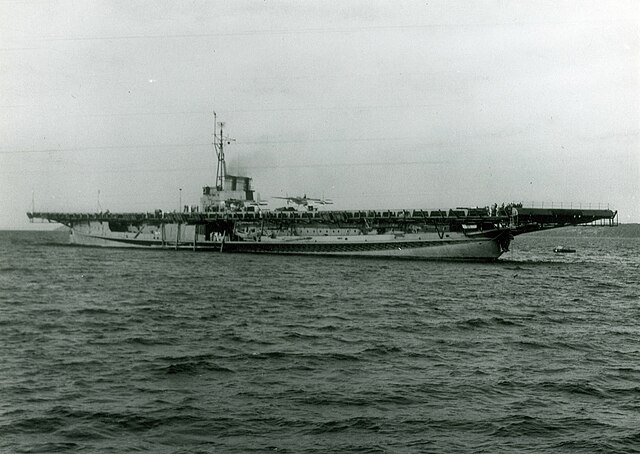 United States Photo: The U.S. Navy training carrier USS Sable (IX-81) launching a Naval Aircraft Factory TDN-1 drone while steaming off Traverse City, Michigan (USA), during flight tests on 10 August 1943. Note this aircraft's unoccupied cockpit. The TDN was intended for use as a television-guided attack drone United States Photo: The U.S. Navy training carrier USS Sable (IX-81) launching a Naval Aircraft Factory TDN-1 drone while steaming off Traverse City, Michigan (USA), during flight tests on 10 August 1943. Note this aircraft's unoccupied cockpit. The TDN was intended for use as a television-guided attack drone Pacific War Pacific War ALEUTIAN ISLANDS CAMPAIGN (Eleventh Air Force): In the Aleutian Islands, P-38's, P-40's, A-24s, B-24's and B-25's bomb and strafe various targets on Kiska Island; direct hits are scored on revetments W of the Wheat Grove and on gun emplacements, as well as on buildings on Little Kiska Island. HQ Eleventh Air Force transfers from Elmendorf Field, Anchorage to Adak Island. SOUTH PACIFIC THEATER OF OPERATIONS (Thirteenth Air Force): In the Solomon Islands, Colonel William A Matheny becomes acting Commanding General, XIII Bomber Command, a position he is officially assigned to on 30 Sep 43. P-40's and P-39's turn back about 40 fighters attacking US bulldozers working on Munda Airfield on New Georgia Island. SOUTHWEST PACIFIC THEATER OF OPERATIONS (Fifth Air Force): 20+ B-24's pound airfields in the Salamaua area; 12 B-25's hit barges in the Lae area and AA positions W of Borgen Bay; and 6 A-20's bomb and strafe barges in Labu Lagoon and Gasmata. Lost after a mid-air collision is C-47 42-23700 near Terapo. PACIFIC Motor torpedo boat PT-161, operating from Rendova, is damaged by Japanese floatplane off Gatere. Other motor torpedo boats engage Japanese craft (fishing boats) in Blackett Strait, sinking Suiko Maru. Submarine Salmon (SS-182) sinks Japanese merchant fishing boat Wakanoura Maru, 46°55'N, 143°30'E. Submarine Tullibee (SS-284) is damaged when rammed by Japanese cargo ship during the submarine's attack on a three-ship convoy on the Saipan-Truk route. USAAF B-24 damages (with a near-miss) Japanese auxiliary sailing vessel No.5 Shinsei Maru west of Cape St. George, 04°50'S, 152°55'E.
|
|
lordroel
Administrator
Posts: 68,086 
Likes: 49,471
|
Post by lordroel on Aug 11, 2022 2:58:37 GMT
Day 1429 of World War II, August 11th 1943
Eastern Front
Konev’s forces cut the main rail line leading into German held Kharkov. 30 miles west of Kharkov the Red Army cut the Poltava--Kharkov railroad.
Air War over Europe
8 Mosquitoes went to Cologne and Duisburg. 23 Wellingtons minelaying off Brest, Lorient and St Nazaire. 1 Wellington lost.
Allied invasion of Sicily
Operation 'Husky' Day 33: Last night another landing on Sicily, east of Cape Orlando, at Brolo was made by US forces. The Germans fell back quickly. Northwest African Tactical Air Force (NATAF) fighter-bombers supported the US Seventh Army's landing east of Orlando, Sicily by attacking troop concentrations, gun positions, and communications lines leading to the area. On the ground in Sicily, US Seventh Army forces took Naso and pressed closer to Randazzo. Medium bombers supported the British Eighth Army by raiding the Fiumefreddo and Randazzo areas.
German forces began a six-day evacuation of Sicily. Over the next six days and seven nights, the Germans evacuated 39,569 troops, 47 tanks, 94 heavy guns, 9,605 vehicles and 2,000+ tons of ammunition to Italy from Messina. In addition, 60,000 Italian troops were evacuated.
In Sicily, 90+ B-25s bombed a bridge, roads, railway, and the city area in and about Randazzo. About 170 P-40s hit Randazzo, shipping at Milazzo and Messina, roads and trains near Messina, and troop movements and evacuations in NE Sicily.
Battle of the Atlantic
Three German submarines were sunk. 'U-468' was sunk near Bathurst, Gambia, by depth charges from an RAF Liberator Mk V of No 200 Squadron based at Yundum, Gambia. The Liberator was shot down by the U-boat crew. 7 of the 51 U-boat crewmen survived. F/O Lloyd Alan Trigg (b.1914), RNZAF, attacked this U-boat while on patrol. The U-boat fought back with its anti-aircraft guns, inflicting fatal damage on the aircraft. He died when his bomber was shot down by blistering anti-aircraft fire, but the U-boat sank soon after. (Victoria Cross).
'U-525' was sunk about 376 miles (605 km) west-southwest of the Azores, by depth charges and aerial torpedoes from a TBF Avenger and an F4F Wildcat of Composite Squadron One (VC-1) in the US escort aircraft carrier USS 'Card' (CVE-11). All hands on the U-boat, 54-men, were lost.
'U-604' was scuttled by her crew in the South Atlantic. The U-boat had been severely damaged by 4 Mark 47 depth charges from a USN PV-1 Ventura of Bombing Squadron One Hundred Twenty Nine (VB-129) based at NAF Ipitanga, Bahia, Brazil on 30 July. The crew of the PV-1 had spotted the U-boat on the surface and after attacking, the U-boat had submerged, resurfaced and submerged again. On 3 August, 'U-604' was again attacked by PB4Y-1 Liberators of Patrol Squadron One Hundred Seven (VP-107) based at NAF Natal, Brazil and the destroyer USS 'Moffett' (DD-362). The U-boat was so damaged that her crew scuttled her and they were taken aboard 'U-172' and 'U-185' for the voyage home. During the rescue 'U-172' was attacked by an American Liberator aircraft from Squadron VB-107, one man from its crew was killed [Maschinenobergefreiter Fritz Schiemann]. 31 of the 45-man crew survived.
'U-64' was scuttled in the South Atlantic, after being badly damaged by depth charges from 2 American aircraft, a Ventura (VB-129) and a Liberator (VB-107). 14 dead and 31 survivors.
Battle of the Mediterranean
In Italy, the Northwest African Strategic Air Force (NASAF) again hit communications targets on the toe of Italy; B-17s hit the marshalling yard at Terni, B-25s bombed the Angitola River bridges and B-26s and P-38s attacked a bridge at Cantanzaro.
Pacific War
ALEUTIAN ISLANDS CAMPAIGN
(Eleventh Air Force): In B-24's, B-25's, A-24s, and P-38's pound Kiska Island targets in 11 attack missions; later, 10 reconnaissance, strafing and photo missions to Kiska are flown by 3 P-38's, 26 P-40's, 4 F-5A's and 1 B-24. 9 B-24's from Attu Airfield drop bombs and incendiaries on Paramushiru, including Kashiwabara Airfield and Shimushu where the Kataoka naval base and staging area are hit. 40 enemy aircraft challenge the attackers, which score 4 confirmed kills, 1 probable, and 4 possibles.
CHINA
(Fourteenth Air Force): The 76th Fighter Squadron, 23d Fighter Group, transfers from Lingling to Hengyang, China with P-40's.
SOUTH PACIFIC THEATER OF OPERATIONS
(Thirteenth Air Force): In the Solomon Islands, 5 B-24's hit a supply area on the E side of Suavanau Point, Santa Isabel Island and on Papatura Fa Island.
SOUTHWEST PACIFIC THEATER OF OPERATIONS
(Fifth Air Force): B-24 on armored reconnaissance sinks an enemy freighter NW of Kavieng on New Ireland Island in the Bismarck Archipelago. The Second Air Task Force completes a movement to Tsili Tsili Airfield, New Guinea
PACIFIC
Submarine Finback (SS-230) damages Japanese auxiliary vessel Tatsumiya Maru, bound for Singapore, at 05°30'S, 120°48'E, and endures counterattack by escorting auxiliary submarine chaser Toseki Maru.
U.S. freighter Matthew Lyon is torpedoed by Japanese submarine I-11 as the ship proceeds toward Espiritu Santo, 13°42'S, 165°59'E, but reaches her destination under her own power. Of the 59 men on board, 41 merchant sailors and an 18-man Armed Guard, only one is injured in the attack.
USAAF B-24 attacks Japanese convoy, bombing minesweeper W.22, 01°20'S, 148°55'E.
|
|
lordroel
Administrator
Posts: 68,086 
Likes: 49,471
|
Post by lordroel on Aug 12, 2022 5:38:46 GMT
Day 1430 of World War II, August 12th 1943Eastern FrontThe Red Army encirclement of Kharkov continued as Soviet forces took Chuguyev and drove on Plotava. The Germans were forced to pull their last major tank force (the 3.Panzerkorps) out of the Taganrog area and move toward Plotava. Hitler ordered the construction of a fortified defensive line (Panther-Steelung) along the Dnepr River. Stukas led by Hans-Ulrich Rudel attacked the Russian ground forces. Covering the Stukas was a flight of 8 Bf 109s from JG 52 led by Lt. Erich Hartmann. After shooting down 2 IL-2s, Hartmann's fighter was hit. He coaxed his damaged Bf 109 down for a belly-landing and removed the clock as per standing orders. His first sight was of a German truck that led him to believe he was within German lines. It turned out to be a captured vehicle being used by Russian infantry. He was quickly captured but faking a stomach pain allowed him to plan an escape. When the chance came, he jumped out of the moving truck and took off in a field of sunflower plants. The Russians gave chase but were unable to catch him and he made good his escape. He later rejoined his unit who had moved from Kharkov-Rogan to Peretschepino. Air War over Europe A Hurricane fighter operating from Milfield airfield, in Northumberland crashed in a grass field at Kimmerston Farm, near Wooler, owing to engine trouble. The pilot was unhurt. The aircraft suffered damage to its propeller and undercarriage. In the first daylight Allied bombing raid in nearly two weeks, 330 B-17s from 16 Bomb Groups were sent to the Ruhr industrial area. One group of bombers, the US 1st BW became scattered and tried for other targets while the rest of the formations were dispersed by heavy flak around Solingen. The escorting P-47 fighters failed to provide effective cover for the scattered groups and the Luftwaffe engaged the bombers. Along with I. and II./JG 26 attacking the bombers were Major Graf's Bf 109s of Jagdgruppe Sud and fighters from all three Gruppen of JG 1. The Americans lost 25 bombers while the Luftwaffe lost 2 fighters, an Fw 190 from 8./JG 26 and another from II./JG 1. One of the victors was Uffz. Jan Schild who claimed his first victory despite being engaged in combat for over a year of operations through France, the Low Countries and the Eastern Front. Although he had claimed 4 previous 4-engined bombers, this was his first to be confirmed. 7 Mosquitoes went to Berlin and 24 Wellingtons minelaying off Brittany ports. 1 Mosquito and 2 Wellingtons lost. Allied invasion of SicilyOperation 'Husky' Day 34: The US Seventh Army continued to pursue the enemy east along the Northern coast. Further inland, US forces gained a favorable position from which to assault Randazzo, but the Germans withdrew during the night, precluding an attack. The British Eighth Army seized Maletto and Riposto. In Sicily, 79 B-25s attacked Falcone, Patti, Novara di Sicilia, and Barcellona; P-40s bombed and strafed shipping at Messina. Northwest African Tactical Air Force (NATAF) P-40s and A-36s hit shipping along the NE coast and in the Straits of Messina, attacked gun positions and vehicles at Capo Calava and east of Randazzo, and hit a bridge at Taormina and roads in the Maletto-Fiumefreddo areas. NATAF bombers attacked Patti, Falcone, Barcellona, and Nunziata. Battle of the MediterraneanIn Italy, Northwest African Strategic Air Force (NASAF) B-25s attacked landing grounds at Crotone, and B-26s hit Grazzanise Airfield; they claimed 9 fighters shot down. 321 Lancasters and 183 Halifaxes raided Milan, 3 aircraft lost. Bomber Command considered that this was a successful raid. Milan only provided a general report which stated that, during August 1943, 4 major factories, including the Alfa-Romeo motor works, the main railway station and the La Scalaopera house were all badly hit and that 1,174 people died in air raids during 1943. Most of these results probably occurred on this night. 112 Stirlings, 34 Halifaxes and 6 Lancasters attacked Turin, 2 aircraft lost. The raid was described by the crews involved as 'heavy and concentrated'. Turin reported only 18 people killed and 83 injured. One of the bravest Victoria Crosses was one on this night. A Stirling of 218 Sqdn was badly damaged by a burst of fire while approaching Turin. The navigator was killed and several members of the crew were wounded, including the pilot, Flight Sergeant Arthur Louis Aaron whose was struck in the face by a bullet which shattered his jaw and tore part of his face away. He was also injured in the chest and his right arm could not be used. The flight engineer and the bomb aimer took over the controls of the aircraft and set course for North Africa although one engine was useless, the pilot was out of action having been dosed with morphia and the navigator was dead. The Stirling reached the coast of Africa and Flight Sergeant Aaron insisted on returning to his seat in the cockpit to help prepare for the landing. Twice he tried to take over the controls and, although he had to give up this attempt, he continued to help by writing down instructions for landing with his left hand. He could not speak. Under Aaron's guidance, in great pain and at the limits of exhaustion, the Stirling landed safely at its fifth attempt at Bone airfield with its wheels up. F/S Aaron died 9 hours later. It was considered that he might have survived if he had rested after having been wounded instead of insisting on helping his crew. The wireless operator, Sergeant T. Guy and the flight engineer, Sgt M. Mitcham were each awarded the Distinguished Flying Medal. It was later established that the machine gun fire which struck the Stirling was fired by a nervous tail gunner in another bomber. Flight Sergeant Aaron was 21 years old and came from Leeds. Luftwaffe aircraft attacked convoy MKS 21 off the coast of Algeria, strafing and holing U.S. freighters SS 'Jonathan Elmer' and SS 'Anne Bradstreet'. U.S. freighter 'Francis W. Pettygrove' was torpedoed and partially abandoned, the survivors that cleared the ship were taken on board RN minesweeper HMS 'Hythe'. The rest of the crew and Armed Guard remained on board to prepare the ship for tow. Photo: The U.S. Navy attack transport USS Thomas Stone (APA-29) beached at Algiers, Algeria, on 12 August 1943. USS Thomas Stone (AP-59) was torpedoed on 7 November 1942 and beached at Algiers, Algeria. She was never returned to service and later scrapped on site. While being beached, she was redesignated APA-29 on 1 February 1943, although her old pennant number was never repainted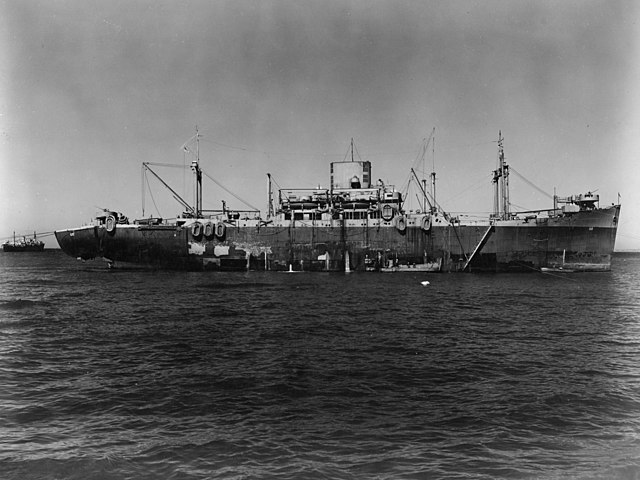 United Kingdom Photo: HMS Ravager, the latest auxiliary cruiser, 12 August 1943, Greenock United Kingdom Photo: HMS Ravager, the latest auxiliary cruiser, 12 August 1943, Greenock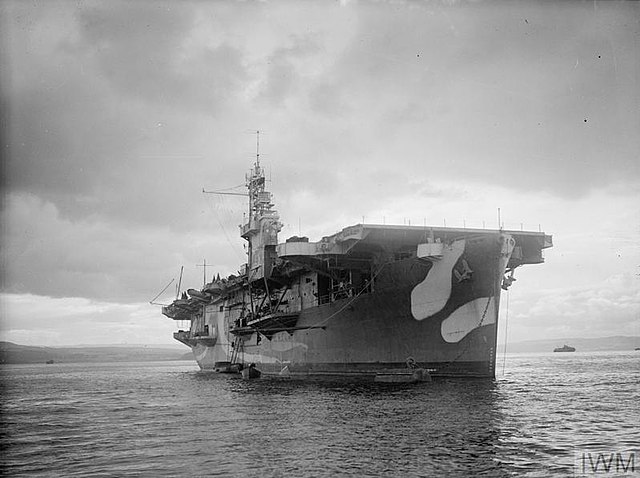 Pacific War Pacific War ALEUTIAN ISLANDS CAMPAIGN The USN Task Unit 16.6.1 consisting of the heavy cruisers USS Indianapolis and USS Salt Lake City, the light cruisers USS Detroit, USS Raleigh and USS Richmond, and 5 destroyers bombard Kiska Island between 0712 and 0733 hours local with 85 rounds of 8-inch, 450 rounds of 6-inch and 1,072 rounds of 5-inch shells. Scouting aircraft are launched by the cruisers to spot the shellfire but damage is difficult to assess because of the excellent camouflage the departed Japanese had used. Later in the day, US Eleventh Air Force B-24s and B-25 Mitchells fly 26 bombing, strafing, and radar and photo reconnaissance sorties over Kiska Island targets from bases on Adak Island. From Amchitka Island P-40s, P-38 Lightnings, B-24s, B-25s, and A-24 Dauntlesses fly 70 bombing sorties over the island and are joined by B-24s, P-40s, and F-5A Lightnings flying 6 reconnaissance and photo sorties. Targets include the runway, harbor and shipping installations, army barracks, and the Rose Hill area. Photo: Kiska Operation, 13 August 1943. Troops march up the beach at Adak, during pre-invasion loading for the Kiska Operation, 13 August 1943. LCM behind the soldiers is from USS Zeilin (APA-3). USS Pennsylvania (BB-38) is in the far right distance. Note the troops' packs and M1 rifles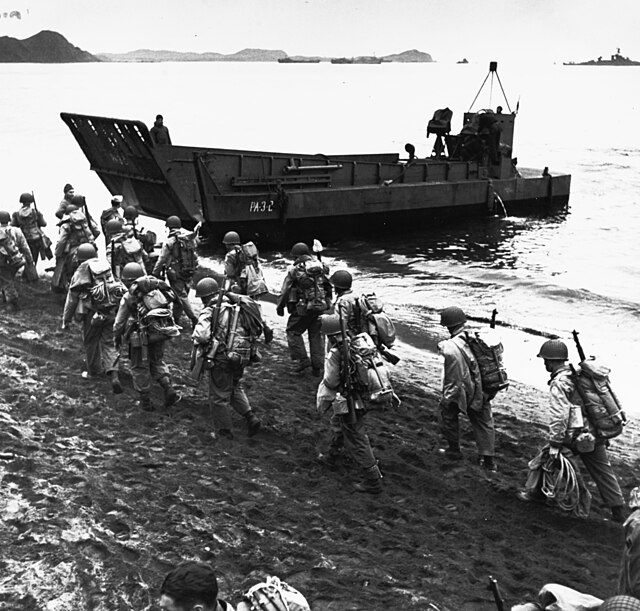 Photo: The U.S. Navy battleship USS Pennsylvania (BB-38) in Adak Bay, Adak, Aleutian Islands, Alaska, on 12 August 1943, just prior to the Kiska operation. A tank landing ship (LST) is in the left background Photo: The U.S. Navy battleship USS Pennsylvania (BB-38) in Adak Bay, Adak, Aleutian Islands, Alaska, on 12 August 1943, just prior to the Kiska operation. A tank landing ship (LST) is in the left background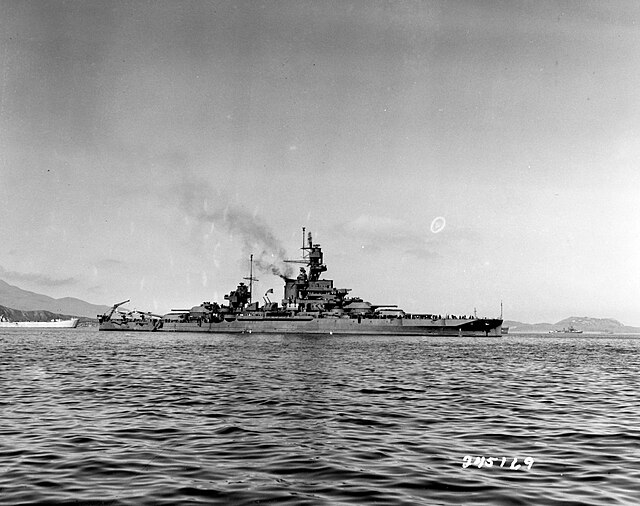 SOUTH PACIFIC THEATER OF OPERATIONS (Thirteenth Air Force): In the Solomon Islands, the US Thirteenth Air Force dispatches 25 B-24s, with 8 P-40s and 22 US Marine F4U Corsairs, to bomb Kahili Airfield on Bougainville Island, causing considerable damage in the dispersal and runway areas. The Allied airplanes claim 11 A6M "Zekes" shot down; 1 P-40 and 1 F4U are lost. During the night, a US Army detachment lands at Barakoma on Vella Lavella Island. SOUTHWEST PACIFIC THEATER OF OPERATIONS (Fifth Air Force): B-25's hit the Bogadjim-Yaula road. A-20's bomb and strafe Gasmata and nearby barges; and a B-24 hits Cape Gloucester Airfield. The 432d Fighter Squadron, 475th Fighter Group, based at Amberley Field near Brisbane, Queensland, Australia begins operating from Port Moresby, New Guinea with P-38's. The squadron will fly it's first combat mission on Friday. PACIFIC Motor torpedo boat PT-168, operating from Rendova, is damaged by Japanese aircraft off Sandfly Harbor and Ferguson Passage. Submarine chaser SC-526 is damaged by grounding off Sicily, 38°01'N, 13°27'E.
|
|
lordroel
Administrator
Posts: 68,086 
Likes: 49,471
|
Post by lordroel on Aug 13, 2022 14:00:47 GMT
Day 1431 of World War II, August 13th 1943YouTube (Manstein Goes Great War Style)Eastern FrontThe Soviet Army captured Bolshaya and Danilovka in their advance. A new offensive began in the Smolensk area and Spas-Demensk, west of Kirov fell. Air War over Europe 61 B-24s hit the Messerschmitt works at Wiener Neustadt in the first Ninth Air Force raid on Austria. Almost no defending fighters intercepted the formation. Unknown to the Allies at the time, the factory was manufacturing rocket components. Allied invasion of SicilyOperation 'Husky' Day 35: On the ground in Sicily, the US Seventh Army entered Randazzo without opposition. Coastal forces continued east toward Patti. NASAF B-17s bombed a marshalling yard at Lorenzi, and B-25s and B-26s hit a marshalling yard at Littoria; other B-25s hit a vessel off Pizzo. P-40s flew a sweep over Sardinia, strafing small boats, a power station, and railroad junction. Northwest African Tactical Air Force (NATAF) light and medium bombers bombed Piedimonte, Italy, Falcone, Sicily, and bridges north of Scaletta, Sicily. A-36s and fighters hit targets in NE Sicily, the Straits of Messina and on the toe of Italy, including Gioia Tauro, Italy and in Sicily, the Barcellona road junction E of Randazzo, the marshalling yard and trucks at Spadafora, trucks between Taormina and Baracca, and barges, ferries, and small vessels in the Strait of Messina. 80+ B-25s hit Piedimonte, Italy, Falcone, Sicily, and shipping at Messina, Sicily. 200+ P-40s attacked shipping and bridges along the SW Italian coast and hit shipping in the Straits of Messina. Battle of the MediterraneanGerman planes attack convoy MKS 21 off the coast of Algeria, strafing and holing U.S. freighters Jonathan Elmer, 36°07'N, 03°07'E, and Anne Bradstreet, 36°19'N, 02°18'E; one man is wounded on board the latter. Freighter Francis W. Pettygrove is torpedoed at 36°08'N, 02°14'E; partially abandoned, the survivors that clear the ship are taken on board British minesweeper HMS Hythe. The rest of the crew and Armed Guard remain on board to prepare the ship for tow. United StatesPhoto: The U.S. Navy destroyer USS Fletcher (DD-445) at the Mare Island Naval Shipyard, California (USA), 13 August 1943. USS Hazelwood (DD-531) is in the background. Note anchor chain, winch and the U.S. Navy Jack at Fletcher's bow; also crewmen on the foredeck smoking cigarettes and clowning for the benefit of the photographer. Circles mark recent alterations, among them the addition of 40mm twin mounts on each side of the forward and midships superstructure Photo: The U.S. Navy destroyer USS Chauncey (DD-667) underway in New York Harbor (USA) on 13 August 1943. Note the Statue of Liberty in the background Photo: The U.S. Navy destroyer USS Chauncey (DD-667) underway in New York Harbor (USA) on 13 August 1943. Note the Statue of Liberty in the background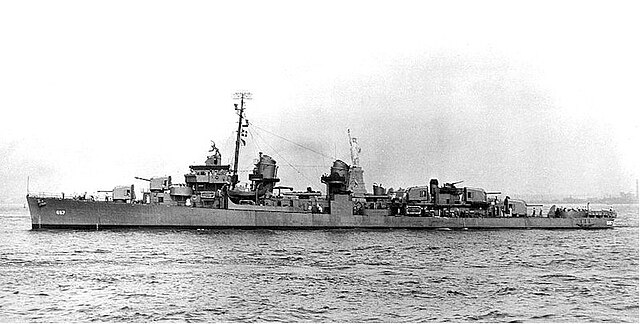 Photo: The U.S. Navy destroyer USS Hazelwood (DD-531) at the Mare Island Navy Yard, California, 13 August 1943 Photo: The U.S. Navy destroyer USS Hazelwood (DD-531) at the Mare Island Navy Yard, California, 13 August 1943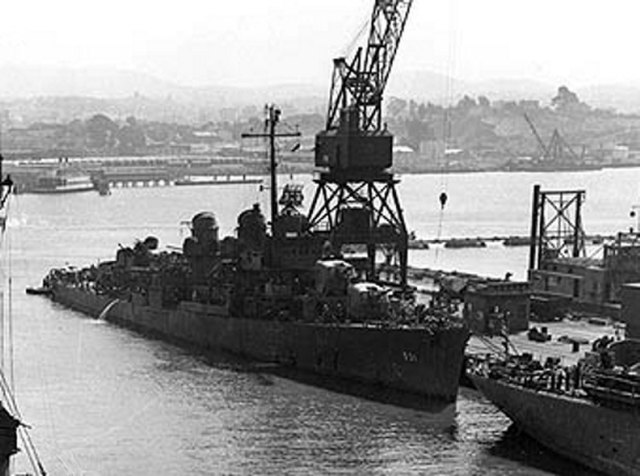 United KingdomPhoto: HM King George VI making a tour of inspection on board HMS Malaya during a visit to the Home Fleet at Scapa Flow,13 August 1943. He is just about to pass a 20 mm Oerlikon anti aircraft gun manned by Royal Marines. In the background can be seen one of Malaya's twin 4 inch anti-aircraft guns, a crane and the former aircraft hangar now used for stowage and flexible use United KingdomPhoto: HM King George VI making a tour of inspection on board HMS Malaya during a visit to the Home Fleet at Scapa Flow,13 August 1943. He is just about to pass a 20 mm Oerlikon anti aircraft gun manned by Royal Marines. In the background can be seen one of Malaya's twin 4 inch anti-aircraft guns, a crane and the former aircraft hangar now used for stowage and flexible use Pacific War Pacific WarSOLOMON CAMPAIGN USS John Penn (APA-51) had just finished unloading a cargo of 155-mm. ammunition off Lunga Point, Guadalcanal. At 2120 she came under attack by enemy torpedo planes. Three minutes later, when the transport took one of the planes under fire, it burst into flames and crashed into her mainmast. About that same instant a torpedo hit from another plane hit the ship. Although vigorous efforts were made to save her, John Penn went down stern first at 2150. PACIFIC Japanese bomber and torpedo planes raid shipping at Guadalcanal, sinking attack transport John Penn (APA-23), 09°23'S, 160°30'E. Motor torpedo boat PT-181, operating out of Rendova, is damaged by near-miss of Japanese bomb off Hunda Cove. Submarine Paddle (SS-263) damages Japanese transport Hidaka Maru, 34°42'N, 136°13'E. Submarine Sunfish (SS-281) sinks Japanese gunboat Edo Maru 180 miles from Chichi Jima, 24°04'N, 142°21'E. U.S. freighter M.H. De Young is torpedoed by Japanese submarine I-19 as the ship proceeds toward Espiritu Santo, 21°50'S, 175°10'E, but though damaged remains afloat due to barge pontoons stowed in each hold. The 25-man Armed Guard remains on board along with the master and two merchant marine officers while the crew and passengers remain nearby (see 14 August 1943). U.S. aircraft sink Japanese guardboat No.15 Dai Nippon Maru in Bismarck Archipelago.
|
|
lordroel
Administrator
Posts: 68,086 
Likes: 49,471
|
Post by lordroel on Aug 14, 2022 6:20:38 GMT
Day 1431 of World War II, August 14th 1943Eastern FrontRussian forces pushing on in ever increasing strength following the recapture of Bielgorod, have taken the southern outposts of the great Ukrainian city of Kharkov. The Germans defending the city were now in great danger of being cut off as Russian tanks worked their way behind their lines. The continuing Russian offensive, part of their master strategy after the great victory at Kursk, involved 120 Russian divisions. Many of these divisions were absolutely fresh and were thrown against Field Marshal von Manstein's battered army of only 42 divisions. The Russian commanders, General Konev and Vatutin, thrusting hard at the join in the German line between the 4.Panzerarmee and the Kampfgruppe, have split them apart and were pouring men through the gap. The apparently inexhaustible supply of Russian divisions was being supported by equally strong aerial formations. There were now 100 Russian air divisions, with 10,000 aircraft patrolling the battlefield. Faced by swarms of Russian planes, the Luftwaffe, forced to withdraw squadrons to defend Germany from Allied bombers, was finding it increasingly difficult to support the Wehrmacht. The question for the German high command now was where to find the reserves to stop the teeming Russians. The Russian 3rd Mountain Division crossed the Kerch strait by ferries and regrouped in Crimea, and 6th Mountain Battalion was assigned to defend the southern shore of Azov Sea, in the gulf of Kazantip. Air War over Europe7 Mosquitoes carried out a nuisance raid on Berlin without loss. Polish C-in-C General Sosnkowski visited RAF No. 315 (Polish) Sqdrn on its Squadron's Day. The 14th August was accepted as Squadron Day to memorize the most outstanding victory of the Squadron, when, on this day in 1941, in a fight over France, they destroyed 8 enemy aircraft, had one probable and another damaged, all without loss. Gen. Sosnkowski decorated 14 pilots with the Polish Cross of Valour, and 2 who were awarded the Virtuti Militari – the highest Polish military award. After lunch, the General addressed the Squadron in the Hangar in a very hearty speech, and then stayed to converse most freely with all ranks. 61 B-24s, on loan from the US Eighth Air Force, bombed the Bf 109 factory at Wiener-Neustadt, Austria. Allied invasion of SicilyOperation 'Husky' Day 36: US and British units captured Randazzo, Sicily. US troops sped east along the coast to the Barcellona area. Battle of the MediterraneanNASAF P-38s swept the toe of Italy but find little enemy movement. Northwest African Tactical Air Force (NATAF) fighters, and medium and light bombers hit a refueling depot at Nicola and near Gesso, Sicily, a road junction N of Palmi, Italy, shipping in the straits and along the W coast of Italy N to Gioia, and numerous targets of opportunity in NE Sicily and S Italy as the enemy continued an orderly evacuation from Sicily to mainland Italy across the Straits of Messina. B-25s attacked road junctions and vehicle concentrations along the NE coast of Sicily and bombed a crossroads N of Palmi, Italy. P-40s hit shipping in the Milazzo and Messina, Sicily areas and along the Italian coast in the Palmi area. In the evening 134 British bombers attacked Milan, Italy. 140 Lancasters of 1, 5 and 8 Groups carried out another attack on Milan, claiming much further damage. 1 Lancaster lost. Perhaps only a general report was provided by the authorities. On orders from General Eisenhower, Lt-Gen Patton apologized to soldiers whom he had struck in a hospital. Submarine HMS 'Saracen' suffered flooding after heavy depth charge attacks by Italian torpedo boats 'Euterpe' and 'Minerva' off Bastia. Unable to control buoyancy, the crew assemble in the control room to make their escape at the surface, and 'Saracen' sinks after being abandoned. German agents watched with more than usual suspicion earlier this week as a senior Italian general flew here for secret talks with the British ambassador. The subject was the new Italian government's anxiety to declare Rome an open city after a second day of heavy bombing by Allied aircraft. Simultaneously, another Italian general was meeting Field Marshal Rommel on the Italian frontier, apparently with the same object in mind. Although the new prime minister, Marshal Pietro Badoglio, announced the news to delighted Romans tonight, Allied sources in Algiers said that they had received no official confirmation that Rome would be "open". A spokesman said that a city could be regarded as "open" only when all ministries, government agencies, military organizations and war industries had gone. "As long as Rome continues to be a German military communications centre, it will constitute a legitimate objective of Allied bombings,"he said. Many cynical observers believe that Badoglio's declaration should be interpreted as proof that Italy will continue to fight on and has no intention of seeking peace with the Allies. U.S. freighter Francis W. Pettygrove, torpedoed while in convoy KMS 21 the day before by German plane, is taken in tow by British minesweeper HMS Hythe. United Kingdom/United States relationsWhile visiting Roosevelt in Hyde park, Churchill and FDR agreed that British and American scientists would completely share all efforts involved in the development of the atomic bomb. United StatesPhoto: The U.S. Navy destroyer USS Charles J. Badger (DD-657) underway at sea on 14 August 1943. The destroyer had been commissioned on 23 July 1943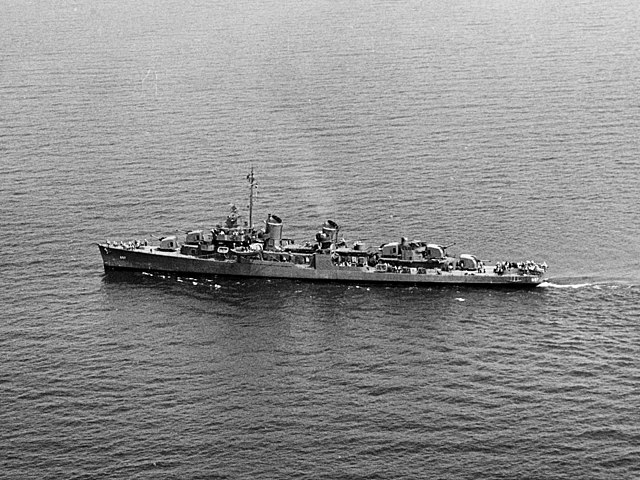 Pacific War Pacific War ALEUTIAN ISLANDS CAMPAIGN (Eleventh Air Force): 7 B-25's from Adak bomb targets at Main Camp and North Head on Kiska and Little Kiska Islands. A B-24 flies a special reconnaissance mission. From Amchitka Island B-24's, B-25's, A-24s, and P-38's fly 8 more bombing missions against Kiska Island pounding the Camp area, gun emplacements, buildings, shipping, and airstrip revetments. The 406th Bombardment Squadron (Medium), 41st Bombardment Group (Medium), ceases operating from Adak Island with B-25's and returns to it's base at Elmendorf Field, Anchorage. During the latter part of Aug 43, the 515th and 516th Fighter-Bomber Squadrons, 407th Fighter-Bomber Group, cease operating from Amchitka Island with A-24s and return to their base at Drew Field, Tampa, Florida. CHINA (Fourteenth Air Force): 4 P-40's bomb and strafe enemy installations at Lungling, China. SOUTH PACIFIC THEATER OF OPERATIONS (Thirteenth Air Force): 4 P-40's become the first Allied aircraft to land on the reconstructed Munda Airfield; after refueling, they are sent on a sweep of the Kolombangara coast; 9 B-17's, with fighter cover, bomb a Kape Harbor depot; and 2 others on armored reconnaissance bomb Vila. 12 B-25's bomb supply areas in the Rekata Bay area; 2 B-24's on armored reconnaissance hit Suavanau Point, 8 bomb the airfield on Ballale. 25 B-24s escorted by 8 US P-40s and 22 F4Us bomb Kahili Airfield, they loose one P-40 and one F4U. Photo: The first fighter plane to land on Munda Point airfield on New Georgia after its capture by Allied forces was a VMF-215 Corsair flown by Maj Robert G. Owens, Jr., on 14 August 1943. Flight operations began immediately to cover the Vella Lavella landings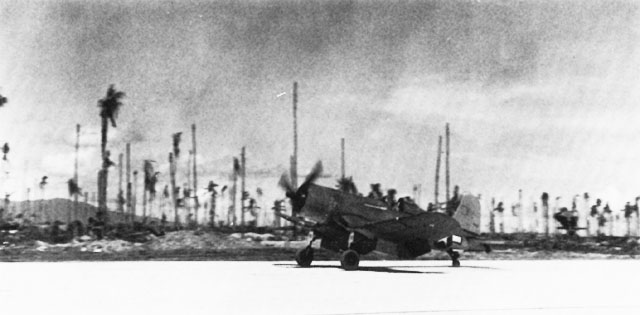 SOUTHWEST PACIFIC THEATER OF OPERATIONS (Fifth Air Force): 59 B-24's, B-17's, and B-26's drop 175 tons of bombs in the Salamaua area in the heaviest single day strike by the Fifth Air Force to date. "The most sensational of the early raids carried out by the 380th BG (Heavy), in view of the planes and techniques available at that time, occurred today, against strategic Balikpapan on the island of Borneo. At 1730, eleven B-24's carrying 69 x 500-pound bombs took off from Darwin and headed out across the Timor Sea in cloudy and turbulent weather. One aircraft was forced to turn back and another failed to find the target, but between midnight and 0145, nine planes hovered over the oil refineries, tanks, and harbor installations, dropped their bombs from between 5,000 and 8,500 feet, and claimed forty-eight 'hits.' As the last plane turned for the long flight back to the base, two refinery areas and one medium-sized vessel were afire and seven large oil-tanks were exploding. In just under seventeen hours from the take-off, eight of the nine aircraft had returned. The ninth, short of fuel, had crash-landed, but all crew members were safe." Photo: B-24 bomber over Salamaua, 14 August 1943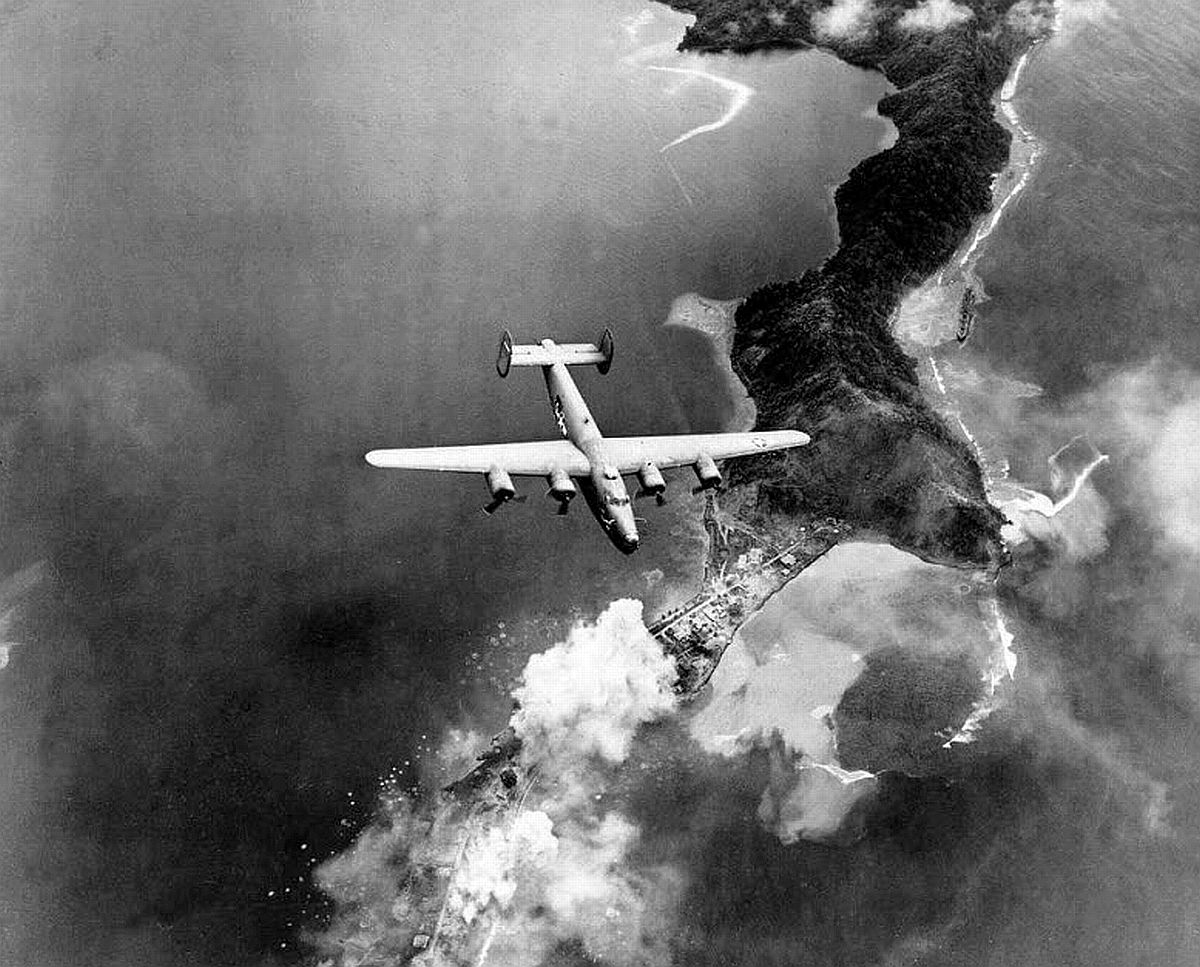 NEW GEORGIA CAMPAIGN Photo: The U.S. Navy destroyer USS Nicholas (DD-449) enroute to the Vella Lavella landings, makes a high speed turn, 14 August 1943. Men are at battle stations watching for enemy planes. Note the depth charges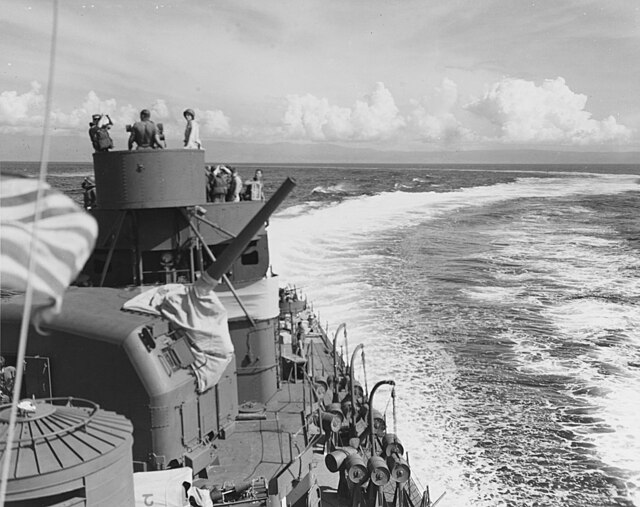 PACIFIC Submarine chaser SC-67 makes rendezvous with damaged U.S. freighter M.H. De Young, torpedoed by Japanese submarine I-19 the previous day, and takes off wounded men to transport to Tongatabu. M.H. De Young is subsequently towed to that port by Canadian steamship Quebec two days later. Japanese auxiliary submarine chaser Cha 109 is damaged by aircraft off Balikpapan, Borneo. USAAF B-25 aircraft sink three Japanese fishing craft, Iboki, 05°33'S, 149°08'E.
|
|
lordroel
Administrator
Posts: 68,086 
Likes: 49,471
|
Post by lordroel on Aug 15, 2022 2:47:14 GMT
Day 1432 of World War II, August 15th 1943Eastern FrontPopov’s Bryansk Front captured Karachev in heavy fighting. Air War over Europe Ninety-one German bombers hit Portsmouth. The US VIII Air Support Command flew Missions 19A, 19B and 20 against targets in France and the Netherlands. 31 B-26B Marauders bombed Ft Rouge Airfield at St Omer France at 0959 hours. 36 B-26Bs were dispatched against Woensdrecht Airfield, The Netherlands. They turned back at the Dutch coast aborting the mission. 19 B-26Bs attacked the marshalling yard at Abbeville, France at 1933 hours. The VIII Bomber Command flew Mission 82 against Luftwaffe airfields in France and the Netherlands. 147 B-17 Flying Fortresses attacked Vlissingen Airfield in the Netherlands and Amiens and Poix Airfield in France at 1926-1931 hours. 143 B-17s bombed Merville, Lille/Vendeville and Vitry en Artois Airfields in France at 1925-1933 hours; 2 B-17s were lost. Jagdgruppe Sud was officially renamed JG 50 and thrown into the latest Allied daylight attack - the attack on airfields in France. An RAF Halifax crashes on a secret mission to supply the Maquis, killing crew and civilians and damaging property. 8 Mosquitoes went to Berlin and 63 aircraft minelaying in the Frisians and off Texel and off all the main Brittany and Biscay ports. 2 Wellingtons and 1 Stirling were lost. A Wellington X belonging to PAF (RAF) 300 Sqdn Bomber Command was engaged in a mine-laying operation off the Frisian Islands. Four minutes before reaching the target area the starboard engine caught fire. The operation was however continued, but 20 minutes later the bomber was attacked by a German night fighter and crashed into the North Sea off Borkum. Pilot F/S M. Rech and W/Op-Air Gnr. F/S C. Poddany survived and managed to get into the aircrafts dinghy in which they drifted for eight days before being sighted and rescued by the German Kriegsmarine to become POW. Two Wellington bombers were lost on this night and Lt. Heinz Grimm of 12./NJG 1 claimed two Wellingtons off Vlieland at 00:07 and 00:36 hours. Combat occurred over the Brest peninsula in the afternoon as Allied fighters swept the area. 'Circus 51' was flown by bomb carrying Whirlwinds of RAF No. 263 Sqdrn, escorted by various fighter units. The Whirlwinds were tasked with bombing Guipavas airfield. RAF No. 193 and 266 Sqdrns were to operate as a free-lance escort but the Whirlwinds were recalled due to bad weather. Not knowing the mission was scrubbed, No. 193 and No. 266 Sqdrns continued on to the Brest peninsula. Over the area, No. 266 Sqdrn spotted enemy aircraft approaching and 6 Typhoons turned to engage. No. 193 had turned to head home when it found No. 266 tangling with Fw 190s. On the night of the 15th, two rangers from RCAF No. 410 Sqdn went out from Castle Camps (used as an advanced base for night Operations) on the Squadron’s first operation with bombs; their target was St.Dizier aerodrome. Lawrence and Wilmer dropped their two 250-lb bombs on the runway and, on the return flight, attacked a train near Paris. Cannon and machine-gun strikes were seen, followed by a vivid blue flash. The second crew, P/O R.D. Shultz and F/O V.A. Williams, did not reach St. Dizier, but had an exciting sortie nonetheless. First three locomotives and three freight cars were damaged between Clermont and Poix and a bridge was bombed; then, 20 miles off Beachy Head on the way home, they met another aircraft and closed to investigate. It proved to be a Do.217 whose under gunner opened accurate fire on the Mosquito. Schultz engaged in a long chase while the enemy pilot tried to shake off pursuit. His second burst hit around the Dornier's cockpit where fires broke out and burning debris fell away. Three, perhaps four, of the crew were seen to bale out. Then, as the Dornier turned toward the French coast in a shallow controlled dive, Schultz fired again. The starboard wing and engine broke away and, completely enveloped in flames, the bomber hit the sea where it continued to burn brightly. After taking some cine camera films of the scene and reporting the position of the crew, Schultz headed for home. En route he flew over an Air/Sea Rescue launch already on its way to the crash. S/Ldr A. S. McIntyre was shot down and killed. F/Sgt Derek Erasmus, a Rhodesian and McIntyre's Number Two, attacked the Fw 190 and shot it down. He then attacked a number of German aircraft and claimed one damaged. He returned to base alone and belly-landed his damaged Typhoon at Portreath. Three other No. 266 pilots closed formation and headed for home at low altitude. Crossing the French coast they found aircraft approaching from the rear. The 3 Typhoons turned to engage but in doing so, F/O F. B. Biddulph stalled and crashed into the sea. The remaining two Typhoons then engaged the German aircraft and became separated. F/L Wright damaged one German fighter. P/O Haworth's two starboard cannon had jammed and 2 Fw 190s continually attacked him. He eventually managed to escape the German and return home. Allied invasion of SicilyOperation 'Husky' Day 37: On Sicily, Patton attempted for a third time to trap German forces facing him with an amphibious “end run”. This time, the Germans had already withdrawn before the sea borne force could land. US Seventh Army troops landed on the Sicilian north coast northwest of Barcellona during the night of 15/16 August to block the enemy withdrawal. The US 3d Infantry Division headed along the north coast to Spadafora. Meanwhile, British forces occupied Taormina. British Eighth Army troops completed a drive around Mount Etna as the Randazzo-Linguaglossa road was closed. Linguaglossa was taken. In Sicily, B-25s hit shipping along the beaches of Sant' Agata di Militello; 180+ P-40s attacked shipping at Messina and in the Straits of Messina. Enemy forces withdrawing to mainland Italy were pounded severely by constant air attacks. German AA along the Straits around Messina damaged 28 of 96 Allied bombers trying to stop the evacuation. Battle of the MediterraneanIn Italy, Northwest African Strategic Air Force (NASAF) B-25s and B-26s bombed Sibari railroad junction and marshalling yard, and P-38s hit trains, troops, radar, and Staletti railroad tracks and tunnel. P-40s attacked a bivouac area near Monserrato, Sardinia. 199 Lancasters continued the offensive against Milan, claiming particularly concentrated bombing. 7 aircraft were lost, mostly to German fighters which were awaiting the bombers' return over France. Lancaster ED 722 of 61 Sqdn was lost, crew lost were P/O J.H. Miller, P/O W. Richards, F/Sgt E.H. Gunders, Sgt E.A. Hall and Sgt J.R. Harrison. Also, W5002 with crew F/O T. Downing, P/O C. Larnach, F/Sgt J.E. Walden, Sgt K. Brentnall, Sgt J. Griffin and Sgt G.A. Angwin. And DV186 with F/O F. Clough, P/O R. Steer, F/Sgt J.D. Pigeau, Sgt A. Hulmes, Sgt P. Salmond, Sgt R.A. Scott and Sgt H.F. Webster. ItalyItalian officials meet with Allied representatives in Spain, offering to defect to the Allies as soon as the invasion of the mainland occurs. They must have forgotten their promise to Ribbentrop on the 6th. United StatesPhoto: The U.S. Navy destroyer escort and USS Greiner (DE-37) during an inclining trial conducted at the Puget Sound Naval Shipyard, Washington (USA), on 15 August 1943 Pacific War Pacific War ALEUTIAN ISLANDS CAMPAIGN (Eleventh Air Force): In the Aleutian Islands, 2 B-24's fly a special radar ferret and reconnaissance mission; 1 B-25, 8 B-24's, and 10 P-38's then fly 2 attack missions to Kiska Island, bombing with unobserved results. Naval task force under Commander North Pacific Force (Vice Admiral Thomas C. Kinkaid) lands U.S. Army and Canadian troops at Kiska, Aleutians (troops landing are the US Army's 17th, 53d and 184th Infantry Regiments, 87th Mountain Infantry Regiment and the 1st Special Service Force. Also landing is the Royal Canadian Army's 13 Infantry Brigade Group). They find Kiska had been evacuated by the Japanese on 28 July 1943. Only casualties in the operation occur because of accidents or friendly fire incidents. Map: The Allied invasion of Kiska, August 15, 1943 Photo: The U.S. Navy destroyer USS Bancroft (DD-598) underway as part of the screen off Kiska, Alaska (USA), during the landings on 15 August 1943. The attack transport USS Harris (APA-2) is visible in the background Photo: The U.S. Navy destroyer USS Bancroft (DD-598) underway as part of the screen off Kiska, Alaska (USA), during the landings on 15 August 1943. The attack transport USS Harris (APA-2) is visible in the background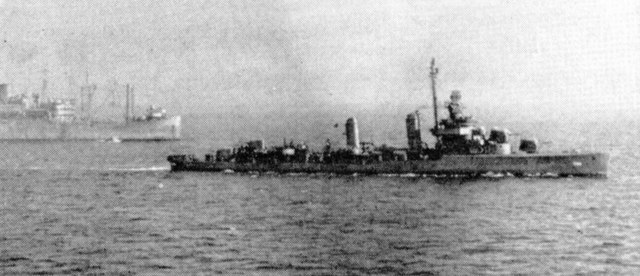 Photo: Allied Landing on Kiska Island, August 15, 1943. Landing craft, carrying American and Canadian invasion troops, move in toward Kiska’s rocky north shoreline, as U.S. Navy transports wait offshore (foreground) Photo: Allied Landing on Kiska Island, August 15, 1943. Landing craft, carrying American and Canadian invasion troops, move in toward Kiska’s rocky north shoreline, as U.S. Navy transports wait offshore (foreground) Photo: Allied Landing on Kiska Island, August 15, 1943. First photographs, landing operations, Kiska, August 15, 1943. This remarkable photograph was taken by a US Navy Vega PV-1 “Ventura”, a patrol bomber operating as part of the air cover for the task force. United States and Canadian troops swarming ashore from landing barges on a stretch of beach along the northwest coast of Kiska. The man can be seen moving up the hillside like ants. At this time, they did not know whether the Japanese were “playing possum” or not. The barges are the familiar LCTs, LCMs, and LCPs, which were also used in the Attu and Sicily Campaigns Photo: Allied Landing on Kiska Island, August 15, 1943. First photographs, landing operations, Kiska, August 15, 1943. This remarkable photograph was taken by a US Navy Vega PV-1 “Ventura”, a patrol bomber operating as part of the air cover for the task force. United States and Canadian troops swarming ashore from landing barges on a stretch of beach along the northwest coast of Kiska. The man can be seen moving up the hillside like ants. At this time, they did not know whether the Japanese were “playing possum” or not. The barges are the familiar LCTs, LCMs, and LCPs, which were also used in the Attu and Sicily Campaigns
 Photo: Allied Landing on Kiska Island, August 15, 1943. Coordinating the job on the Kiska beach. Each member of the landing party with his specified job to do, the problem of occupying Kiska goes forward. Men in foreground (before megaphone) direct landing operations in this sector. Directly in front of them others load 105mm ammunition on tractor-trailer. This was the first day of the invasion, but Americans and Canadians had already extended a long earthen ramp into the water to help the leaders avoid underwater rocks Photo: Allied Landing on Kiska Island, August 15, 1943. Coordinating the job on the Kiska beach. Each member of the landing party with his specified job to do, the problem of occupying Kiska goes forward. Men in foreground (before megaphone) direct landing operations in this sector. Directly in front of them others load 105mm ammunition on tractor-trailer. This was the first day of the invasion, but Americans and Canadians had already extended a long earthen ramp into the water to help the leaders avoid underwater rocks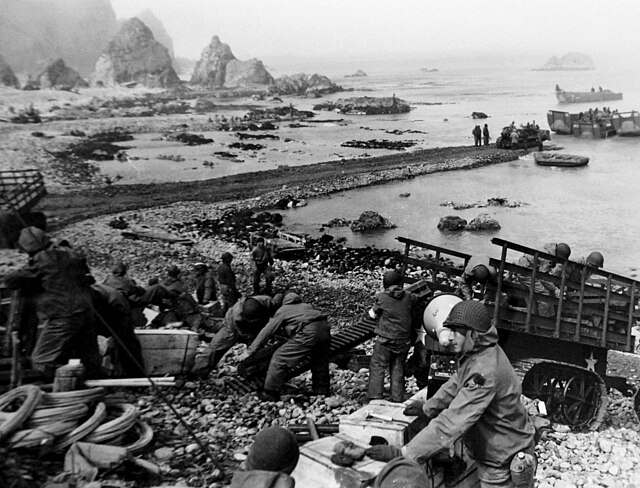 Photo: Kiska Landing, August 15, 1943. Soldiers getting off their landing craft onto the rocky shores of Kiska Island, Alaska, on invasion day, assisted by U.S. Navy Seabees Photo: Kiska Landing, August 15, 1943. Soldiers getting off their landing craft onto the rocky shores of Kiska Island, Alaska, on invasion day, assisted by U.S. Navy Seabees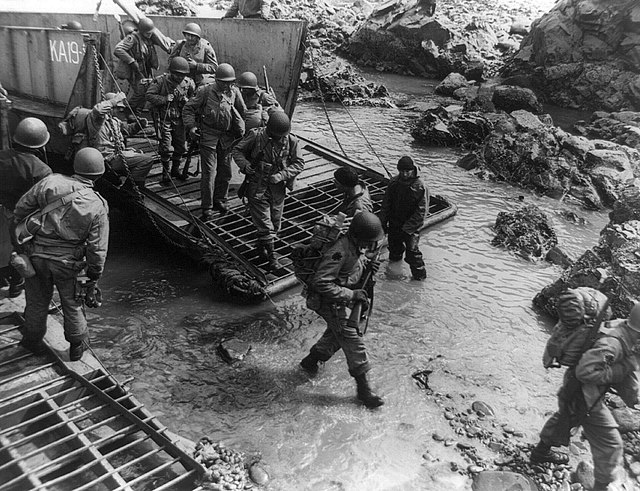 SOUTH PACIFIC (Thirteenth Air Force) 9 B-17's bomb the Rekata Bay area. SOUTHWEST PACIFIC (Fifth Air Force) In New Guinea, 50+ B-24's, B-17's, and B-25's pound the Salamaua area battle zone; with close air and artillery support, US forces push to the crest of Roosevelt Ridge; the enemy retains several ridges along Dot Inlet; and A-20's strafe barges near Finschhafen. On New Britain Island in the Bismarck Archipelago, B-25's hit barges at Talasea and Rein Bay, and other B-25's bomb Koepang on Timor Island. HQ 475th Fighter Group and it's 431st, 432d and 433d Fighter Squadrons transfer from Amberley Field to Dobodura, New Guinea with P-38's. The 431st and 432d are operating from Port Moresby, the 431st until Oct 43 and the 432d until Sep 43; the 433d will fly it's first mission tomorrow. NEW GEORGIA CAMPAIGN - BATTLE OF VELLA LAVELLA (LAND) Third Amphibious Force (Rear Admiral Theodore S. Wilkinson) lands Navy, Marine, and Army personnel at Vella Lavella, Solomons, thus by-passing enemy positions on Kolombangara, Solomons. Map: Map of the land battle on Vella Lavella, 1943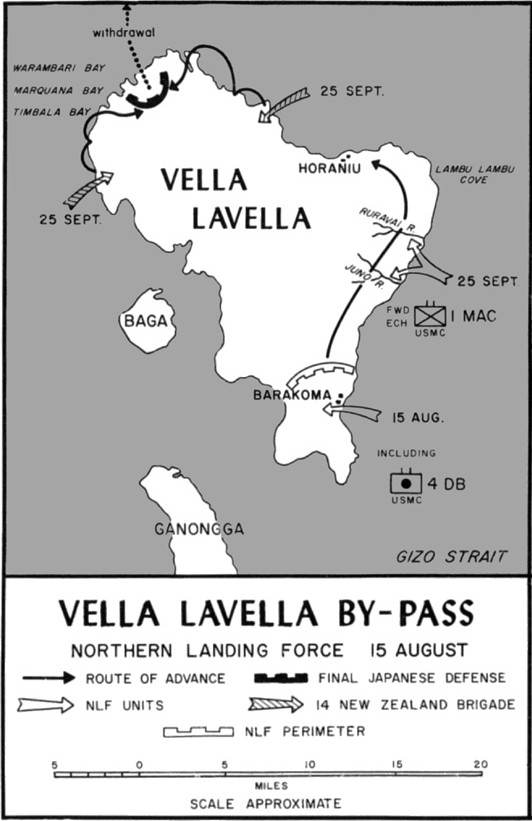 Photo: Three of the U.S. Navy Destroyer Squadron 21's ships underway in the Solomon Islands, 15 August 1943. The ships are (from front to rear): USS O'Bannon (DD-450), USS Chevalier (DD-451) and USS Taylor (DD-468). Photographed from USS Nicholas (DD-449), while the ships were enroute to the landings at Vella Lavella, which took place on the same day Photo: Three of the U.S. Navy Destroyer Squadron 21's ships underway in the Solomon Islands, 15 August 1943. The ships are (from front to rear): USS O'Bannon (DD-450), USS Chevalier (DD-451) and USS Taylor (DD-468). Photographed from USS Nicholas (DD-449), while the ships were enroute to the landings at Vella Lavella, which took place on the same day PACIFIC Submarine Wahoo (SS-238) damages Japanese fleet tanker Terukawa Maru, 43°15'N, 140°03'E, and merchant fishery mother ship Ryokai Maru, 43°12'N, 140°00'E.
|
|
lordroel
Administrator
Posts: 68,086 
Likes: 49,471
|
Post by lordroel on Aug 16, 2022 2:48:53 GMT
Day 1433 of World War II, August 16th 1943Eastern Front Popov’s Bryansk Front continued to make good progress in the Smolensk area, capturing Zhidra, near Bryansk. Far to the south, the Southwest Front opened a fresh set of attacks against the Mius River line. Air War over Europe 179 B-17s and 1 YB-40 were dispatched to Le Bourget air depot in the Paris area. 171 hit the target at 0929-0937 hours and claimed 29-3-11 Luftwaffe aircraft. 4 B-17s were lost and 46 damaged. The mission was escorted all the way to the target by P-47s using drop tanks. 66 B-17s were dispatched to Poix and Abbeville Airfields. All 66 hit the targets at 0911-0923 hours and 38 aircraft were damaged with no casualties. 36 B-26s were dispatched to Bernay St Martin Airfield. 31 hit the target at 1117 hours and 2 aircraft were damaged. Allied invasion of SicilyOperation 'Husky' Day 38: Montgomery attempted an “end run” on the east coast of Sicily but it failed to prevent the Germans from making a successful withdrawal. US reconnaissance forces entered Messina. Nearly 100,000 Axis troops were successfully evacuated from the island. Another 46 out of 96 Allied bombers trying to stop the evacuation were damaged by German AA guns in the straits including over 30 fighter-bombers. 86 US Ninth Air Force B-24s bombed the Messian area and 100+ P-40s hit shipping at Messina and in the Straits of Messina, as the enemy continued the withdrawal of rear guard troop to mainland Italy. Before midnight, US patrols entered Messina, which was under fire from the Italian coast. Battle of the MediterraneanThe armed U.S. freighter SS 'Benjamin Contee' was hit by an aerial torpedo 16 miles (25.7 km) north of Bone, Algeria. The ship was carrying 1,800 Italian POWS, 26 British guards and 7 US Army security men. the explosion kills 264 POWS and injures another 142. The ship was in no danger of sinking and later returned to service only to become a sunken block ship at Normandy 10 months later. 154 British bombers attack Turin, Italy during the evening. 103 Stirlings, 37 Halifaxes and 14 Lancasters attacked Turin, 4 aircraft lost. Crews claimed a concentrated attack on Turin, including damage to the Fiat motor works but the city's casualties were much lower than in recent raids, only 5 dead and 56 injured. This raid concluded the Bomber Command attacks on Italian cities which had commenced in June 1940. Allied high command agreed that Italy should be the next target, quickly before a massive German build-up of forces could take place. United KingdomPhoto: HM King George VI greeting the Flag Officers of the Home Fleet on board the flagship HMS Duke of York at Scapa Flow: (left to right) Rear Admiral I G Glennie, Rear Admiral L H K Hamilton, CB, DSO, Rear Admiral R L Burnett, CB, OBE, DSO (shaking hands with The King), Vice Admiral Sir Henry R Moore, KCB, CVO, DSO, King George VI, and Admiral Sir Bruce Fraser, KBE, CB, Commander in Chief Home Fleet. The quadruple 14 inch Y turret can be seen in the background, stood next to it is the Royal Marine band. The king was taken there on board the flotilla leader Onslow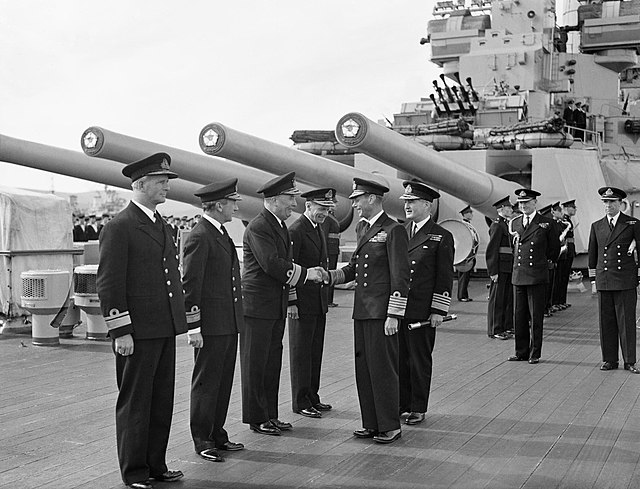 United States Photo: The U.S. Navy dock landing ship USS Belle Grove (LSD-2) undergoing sea trials in San Francisco Bay (USA), on 16 August 1943 United States Photo: The U.S. Navy dock landing ship USS Belle Grove (LSD-2) undergoing sea trials in San Francisco Bay (USA), on 16 August 1943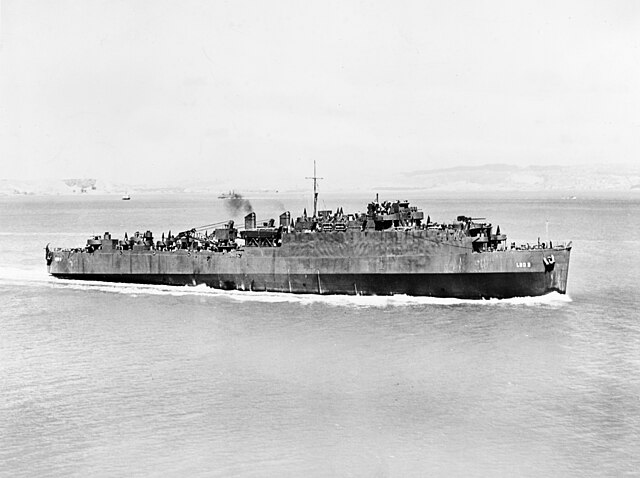 Photo: The U.S. Navy aircraft carrier USS Intrepid (CV-11) underway off Newport News, Virginia (USA), on 16 August 1943, the day she went into commission. Note the hangar catapult forward Photo: The U.S. Navy aircraft carrier USS Intrepid (CV-11) underway off Newport News, Virginia (USA), on 16 August 1943, the day she went into commission. Note the hangar catapult forward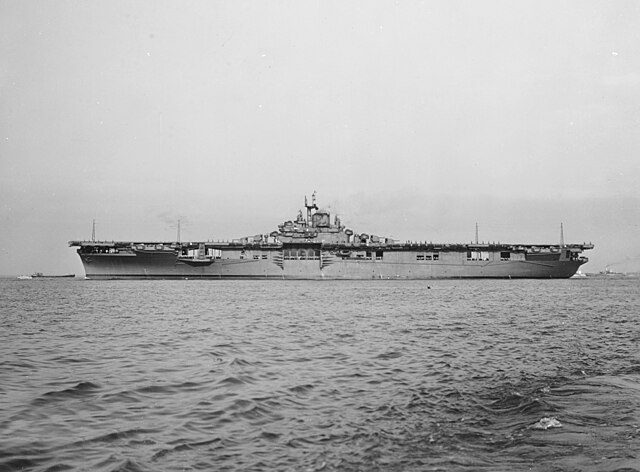 Pacific War Pacific War SOUTH PACIFIC (Thirteenth Air Force): Commander Air (COMAIR), New Georgia command post, recently opened at Munda Point by Major General Francis P Mulcahy, USMC, conducts its first full day of operations. Fighters are sent to cover amphibious landings at Vella Lavella where elements of the 25th Infantry Division, and supporting units, go ashore in the Barakoma area and establish a beachhead. Allied airplanes knock down about 25 Japanese aircraft (7 by Army Air Forces fighters) attacking the landings. F4U's also claim 10 Japanese shot down over Kahili. B-25's bomb Papatura Fa and Ighiti Islands in the Rekata Bay area of Santa Isabel Island. SOUTHWEST PACIFIC (Fifth Air Force): Ki-48 Lilys of the 208 Sentai led by 1/Lt Imai, escorted by 22 Ki-43 Oscars of the 59th Sentai and 12 Ki-43 Oscars of the 24th Sentai attack Tsili Tsili Airfield for the first time; intercepting P-39's claim 14 airplanes downed for the loss of 3 P-39's. Lost are C-47 "Liliane" 41-18682 and C-47 41-18668. the passengers were personnel of the 41st FS. The 41st was one of the units intercepting. Also lost were 4 P-39s. American claims included 9 of a total of 11 claims for Lily. (Actually only 7 Ki-48s were in the raid). They also claimed 2 of the 3 OSCARS shot down. Japanese losses 6 bombers, 3 fighters. Among the Ki-48 Lily losses were 1210, 1235, 1242, 1249 and 1250 (wrecks inspected at Tsili Tsili, Pesen, and Babauf). Also lost is P-400 AP 347. ALASKA (Eleventh Air Force): A P-38 bombs and strafes Sniper Hill. The 635th Bombardment Squadron (Dive), 407th Fighter-Bomber Group, based at Drew Field, Tampa, Florida but operating from Amchitka Island, is disbanded and it's A-24s are transferred to other units. AUSTRALIA Photo: The U.S. Navy destroyer seaplane tender USS Childs (AVD-1) docked up at Fremantle, Western Australia, on 16 August 1943. The small cabin cruiser in the foreground is the Royal Australian Navy patrol boat P-18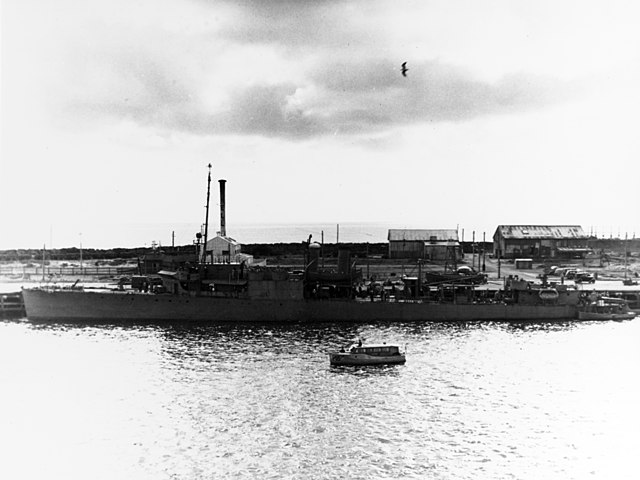
|
|
lordroel
Administrator
Posts: 68,086 
Likes: 49,471
|
Post by lordroel on Aug 17, 2022 2:46:17 GMT
Day 1434 of World War II, August 17th 1943Air War over Europe The Regensberg/Schweinfurt Raid: On the one year anniversary of its first mission, the US VIII Bomber Command launched its most complex mission of the war. In an effort to destroy the production facilities of German fighters, over 350 bombers (formed into 2 divisions, the 1st and 3d BD) took to the skies in a dual effort to bomb both a Messerschmitt plant in Regensberg and the ball bearing plant at Schweinfurt. 376 B-17s were to make the initial penetration as one force then split with 230 B-17s attacking Schweinfurt and returning to England. The remaining 146 B-17s would attack Regensberg and then continue to Allied bases in Algeria. Timing was critical in an effort to divide the defending Luftwaffe forces. But events went badly from the beginning. While the Regensberg bound 3d BD was taking off, the Schweinfurt bound 1st BD was grounded by fog and unable to take-off for 3 hours. This meant that the forces would be attacking separately and German fighters, rather than being divided, could concentrate on each force, sequentially. Shortly after 10:00 hours the 3d BD crossed the Dutch coast and met the first of 3 Luftwaffe groups with about 60 fighters. The Fw 190s of II./JG 1 and JG 26 were the first to make contact and Major Borris, Gruppenkommandeur of I./JG 26 destroyed the first bomber after a frontal attack. After this first encounter, 4 B-17s had been shot down and 2 more bombers fell to flak. Crossing into German airspace, the Luftwaffe waited until the escorts turned back and continued the attack. Over Wiesbaden, Major Graf's JG 50 sent 25 Bf 109s along with scores of Fw 190s and Bf 109s, some flown by instructors from training units in the area. Head-on attacks followed by attacks from the rear hit the 100th BG very hard. Oblt. Grislawski of 1./JG 50 downed 2 B-17s for his first victories in the west. More Gruppen of German fighters joined in the attack, including Bf 110s from II./NJG 1 and after 90 minutes, 14 B-17s were shot down. But the bombers reached their target and dropped accurately. The bomber formation continued on to Algeria loosing 7 more planes for a total of 24 bombers lost from a force of 146. Luftwaffe fighters landed and refueled and the OKL ordered more fighter Gruppen from the north and other areas to contact the Regensberg force on its return flight. But instead this mass of German fighters met the 1st BD on its way to Schweinfurt. Not waiting until the escorts left, the first fighters into the battle were from JG 11. Over 300 re-armed and refueled fighters from JG 1, JG 2, JG 11, JG 26, ZG 26 and 1./NJG 1 - twice as many fighters as those who flew against the morning bomber formations - met the Americans. Passing over Eupen, the worst fighter attacks occurred and 15 B-17s were lost. The air was full of blazing planes, cannon fire and rockets as the B-17s fought their way through, their formidable half-inch machine guns covering each other, closing up the formation as stricken aircraft staggered and fell out of position. The bombers suffered heavy casualties. The bombers made it to the target, released their bombs then turned for home, back through the cauldron of German fighters. Reaching Eupen, the first escorting P-47s arrived and tore into the German fighters. Fw 190s from II./JG 26 met the Thunderbolts of the US 56th FG and clashed over Lutych. Major Wilhelm-Ferdinand 'Wutz' Galland (55 kills), Gruppenkommandeur of II./JG 26 was shot down and killed in a crash near Maastricht. Two more B-17s were shot down. III./JG 3 led by Hptm. Walther Dahl were in their first action since the Eastern Front and was attacked by Spitfires from RAf No. 222 Sqdrn., who had their best day since 1940. Five Bf 109s from JG 3 were shot down including Ritterkreuztrager Lt. Hans Schleef, who survived. Oblt. Dahl had to crash-land near Capperath. III./JG 1 claimed 12 bombers at a loss of 5 Bf 109s. The final loss to the American bombers was devastating. 60 B-17s were shot down and another 168 severely damaged. Most heavily hit were groups the 91st BG which lost 10 planes and the 381st BG which lost 11. Photo: Boeing B-17F formation over Schweinfurt, Germany, on Aug. 17, 1943 Although the Allies claimed 288 German fighters destroyed, the Luftwaffe suffered 27 fighters lost. Heavy damage was caused at several of the Allied targets It took approximately 4 weeks to repair the damage at the Messerschmitt plant at Regensberg. Production of the Me 262 had to be relocated to Oberammergau near the Bavarian Alps. Delivering the temperamental Jumo 004 turbojets was even more troublesome. The Peenemunde Raid: The RAF sent 324 Lancasters, 218 Halifaxes and 54 Stirlings to attack Peenemunde, the German research establishment on the Baltic coast where V-2 rockets were being built and tested, during the night. This was the first raid in which 6(Canadian)Group operated Lancaster aircraft. 426 Squadron dispatched 9 Mark11 Lancasters, losing 2 aircraft including that of the squadron commander, Wing Commander L. Crooks, D.S.O, D.F.C., an Englishman who was killed. The raid was carried out in moonlight to increase the chances of success. There were several novel features. It was the only occasion in the second half of the war when the whole of Bomber Command attempted a precision raid by night on such a small target. For the first time there was a Master Bomber controlling a full scale Bomber Command raid. Group Captain J.H. Searby of 83 Squadron, 8 Group, carried out this task. There were three aiming points - the scientists' and workers' living quarters, the rocket factory and the experimental station - and the Pathfinders employed a special plan with crews designated as 'shifters' who attempted to move the marking from one part of the target to another as the raid progressed. Crews of 5 Group, bombing in the last wave of the attack, had practiced the 'time and distance' bombing method as an alternative method for their part in the raid. The Pathfinders found Peenemunde without difficulty in the moonlight and the Master Bomber controlled the raid successfully throughout. As a diversion, 20 Mosquitoes were sent over Berlin, dropping massive amounts of flares as if Berlin was the target. 148 twin-engined nightfighters and 55 single-engined fighters - the first night with the 'Wilde Sau' up in full strength - were dispatched. Searching the skies over Berlin, they found nothing except to be fired on by the city's flak batteries. Unfortunately, the initial marking and bombing fell on a labour camp for forced workers which was situated 1 1/2 miles south of the first aiming point but the Master Bomber and the Pathfinders quickly brought the bombing back to the main targets which were all bombed successfully. 560 aircraft dropped nearly 1,800 tons of bombs. 85% of this tonnage was high explosive. After the first bombs fell on Peenemunde, the fighters raced to intercept the bombers. Pouncing on the final wave of British bombers, several pilots increased their scores. Lt. Dieter Musset of 5./NJG 1 destroyed 4 bombers out of a group of 8. Major Ehle of II./NJG 1 claimed 2 bombers. Along with the 'Wilde Sau' tactic, the 'Zahme Sau' tactic was also used for the first time. Another innovation used for the first time against the British bombers was the 'Schrage Musik' gun installation. Mounted on Bf 110s from II./NJG 5, 2 MK-108 cannon fired obliquely upward from behind the cockpit and were used to good effect. Two of these aircraft found the bomber stream flying home from Peenemunde and are believed to have shot down 6 of the bombers lost on the raid. Uffz. Holker of 5./NJG 5 brought down 2 bombers using this arrangement. In total the RAF lost 40 bombers with another 32 damaged. Most of the casualties were suffered by the aircraft of the last wave, which included 61 Sqdn, when the German night fighters arrived in force. The groups involved were 5 Group which lost 17 of its 109 aircraft on the raid (14.5%) and the Canadian 6 Group which lost 12 out of 57 aircraft (19.7%). This raid set back the V-2 experimental programme by at least 2 months and reduced the scale of the eventual rocket attacks. Approximately 180 Germans were killed at Peenemunde, nearly all in the workers' housing estate and 500-600 foreigners, mostly Polish, were killed in the workers' camp where there were only flimsy wooden barracks and no proper air raid shelters. The losses were considered an acceptable cost for the successful attack on this important target on a moonlit night. Although the grounds of the rocket center were damaged, neither the vital testing blocks nor the construction drawings were destroyed. But the attack did cause a delay in another Luftwaffe project. A group of 30 pilots were due to arrive there to begin training to fly the Me 163. Erprobungskommando 16 (EK 16), an operational training unit commanded by Major Spate was formed in July 1943 and had 8 Me 163s to work up. The unit had to move to Bad Zwischenahn before the pilots arrived as a result of the bombing. Allied invasion of SicilyOperation 'Husky' Day 39: Patton’s 7th Army marched into Messina, followed closely by Montgomery’s 8th Army, thus completing the conquest of Sicily for the Allies. During the 39-day campaign, the Axis forces suffered 167,000 casualties (37,000 German, 130,000 Italian). Allied losses were 25,000. Most deemed this a great Allied victory, but in retrospective, it was a bitter one in that, had the Allied planning been more bold, they easily could have destroyed all of the forces on the island rather than allowing so many to escape. The Germans left in an orderly evacuation. The booty of captured weapons, fuel and ammunition was huge; but nothing could compensate for the sight of the civilian population emerging from cellars and other hiding places to see their beloved Messina almost flattened by not only Allied bombs and artillery but also, now, shells from the Italian mainland. The fall of Sicily paved the way for the stepped-up air offensive against Italy. Battle of the AtlanticPortugal agrees to grant bases in the Azores to Great Britain. Battle of the MediterraneanCommander Motor Torpedo Boat Squadron 15 (Lieutenant E.A. Dubose, USNR), after unopposed landings from motor torpedo boats PT-215, PT-216 and PT-217 on islands of Lipari and Stromboli, accepts the unconditional surrender of the Lipari Islands (Alicudi, Filicudi, Vulcano, Stromboli, Salina and Lipari). Destroyer Trippe (DD-403) covers the operation. Infantry landing craft LCI-1 is sunk by aircraft off Bizerte, Tunisia. United StatesPhoto: Launching of Launching of LST-42, 17 August 1943, at Dravo Corp., Neville Island, PA., at Dravo Corp., Neville Island, PA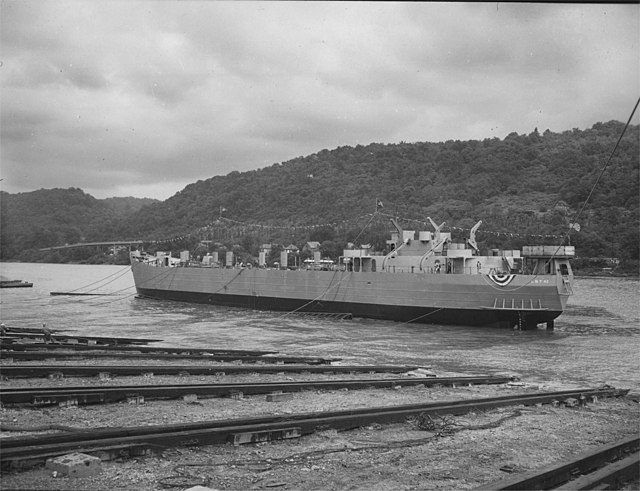 Pacific War Pacific War BURMA-INDIA (Tenth Air Force): Bombers hit and claim 2 small vessels sunk about 130 miles (208 km) S of Rangoon, Burma. The 89th Fighter Squadron, 80th Fighter Group, transfers from Karachi to Gushkara, India with P-40's. The squadron will fly it's first mission on 8 Sep 43. CHINA (Fourteenth Air Force): 4 P-40's bomb town of Tengchung, China. SOUTH PACIFIC THEATER OF OPERATIONS (Thirteenth Air Force): 9 US Thirteenth Air Force B-24s bomb Papatura Fa Island while 12 B-25 Mitchells, 5 B-17s, and 30+ USMC aircraft attack Vila Airfield on Kolombangara Island. On New Georgia Island, Munda airfield is bombarded by IJN artillery on Baanga Island. SOUTHWEST PACIFIC THEATER OF OPERATIONS (Fifth Air Force): Oil tanks at Balikpapan, Borneo are hit by 2 B-24's. In New Guinea, 5 B-25's bomb Larat; 15 P-38's and 32 P-47's intercept 25 fighters preparing to attack transport vessels near Tsili Tsili; the strike is completely thwarted and 12 fighters shot down. This marks first the combat use of the P-47 in this theater. ALASKA (Eleventh Air Force): In the Aleutian Islands, a B-24 reconnais- sance flight reconnoiters North Head, Main Camp, and northern Kiska Island, and observes friendly forces' unopposed advance into Main Camp. PACIFIC Destroyers Waller (DD-466) and Philip (DD-498) are damaged by collision off Barakoma, Solomons, 08°11'S, 156°43'E, while defending convoy against Japanese air attack. USAAF B-24s damage Japanese cargo vessel Amagisan Maru off Balikpapan.
|
|
lordroel
Administrator
Posts: 68,086 
Likes: 49,471
|
Post by lordroel on Aug 18, 2022 2:47:39 GMT
Day 1435 of World War II, August 18th 1943Battle of the AtlanticThe German submarine 'U-403' was sunk in the mid-Atlantic Ocean near Dakar, by depth charges from a French Wellington Mk XIII of the RAF's No 344 Squadron based at Quakram Airfield, Dakar, French West Africa. All hands, 49 men, on the U-boat were lost. Air War over EuropeThe US VIII Air Support Command in England flew Missions 25A and 25B against 2 Luftwaffe airfields without loss. 22 B-26B Marauders bombed the Vlamertinge Airfield at Ypres, Belgium and 32 B-26Bs attacked Woensdrecht Airfield in the Netherlands. 30 Wellingtons went on leaflet raids to France without loss. Battle of the MediterraneanUS cruisers and destroyers bombarded Palmi and Gioai Taura. P-40s attack motor transport between Scilla and Bagnara, and bombed shipping off Scilla. Northwest African Strategic Air Force (NASAF) fighters and medium bombers hit barracks and railroad at Gonnesa, sank a small vessel in the Golfo di Sant' Eufemia and bombed and strafed a railway station, bridge, and tracks at Soverato, bridges and a road junction at Angitola, and highway and road junction at Staletti. Northwest African Tactical Air Force (NATAF) air-planes hit gun positions and road and rail transport in S Italy. Battle of the AtlanticAdvanced Amphibious Training Base, St. Mawes, Cornwall, England, is established. Germany In East Prussia, an early morning phone call from the chief of Luftwaffe operations staff, General Rudolf Meister to Generaloberst Hans Jeschonnek informed him that Peenemunde had been raided by the RAF. Jeschonnek called his personal adjutant Major Werner Leuchtenberg and ordered him to the rocket-testing ground. His secretary waited for the Generaloberst to join her at breakfast. After an hour, Frau Lotte Kersten called his room but received no answer. Going to his room, she found Jeschonnek dead of a pistol shot. A note found by Leuchtenberg stated in Jeschonnek's handwriting; "I can no longer work together with the Reichsmarschall. Long live the Fuhrer!" General Gunther Korten was named in Jeschonnek's place as the new chief of the general staff. United StatesPhoto: The U.S. Navy aircraft carrier USS Wasp (CV-18) immediately after her launch at the Fore River Shipyard, Quincy, Massachusetts (USA), on 18 August 1943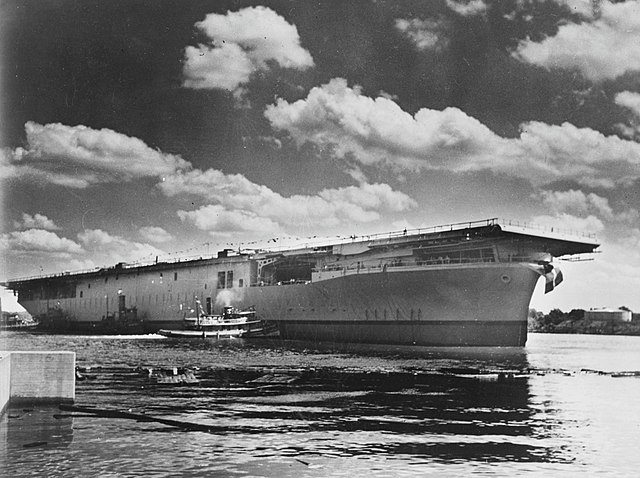 Pacific War Pacific War CHINA (Fourteenth Air Force): 23 B-24's, operating in 3 waves, bomb barracks at Cau Lo, French Indochina. 4 P-40's bomb town of Mangshih, China. SOUTHWEST PACIFIC THEATER OF OPERATIONS (Fifth Air Force): 50+ B-24's and B-17's make a predawn attack on Wewak and satellite airfields at Boram, Dagua, and But, and also hit Tadji and Madang. Lost is B-24D 41-40981, during the midmorning, 30+ B-25's, with 80+ P-38's covering, carry out the day's second bombing and strafing strike on Boram, Wewak, and Dagua; this begins a campaign to neutralize Japanese airfields in preparation for offensive against Lae; Lost is B-24D "Twin Niftys" 42-40348. A-20's again hit enemy forces in the Salamaua area. B-24's bomb oil facilities at Balikpapan. NEW GEORGIA CAMPAIGN In the Solomon Islands, new ground troops are landed on Vella Lavella Island despite air attacks by the Japanese. At dusk, several Japanese aircraft attack shipping and sink an LST and destroy an early-warning radar site. On New Georgia Island, Japanese artillery on Baanga Island continues to shell Munda Airfield. Task group composed of four destroyers (Captain Thomas J. Ryan) attacks Japanese convoy north of Vella Lavella, Solomons; destroyers Nicholas (DD-449), Chevalier (DD-451), O'Bannon (DD-450), and Taylor (DD-468) sink auxiliary submarine chasers Cha 5 and Cha 12. ALASKA (Eleventh Air Force): In the Aleutian Islands, 1 B-24 flies over Kiska Island watching friendly forces land on the shore of E Kiska Lake. AUSTRALIA Photo: Fremantle, Australia, August 18th 1943, return of the 9th Australian Division from the Middle East. The Nieuw Amsterdam with troops aboard, entering Fremantle Harbaour, HM transport Queen Mary in the background PARAMUSHIRU ISLAND Photo: B-24 Raid on Paramushiru Island - Japan - 18 August 1943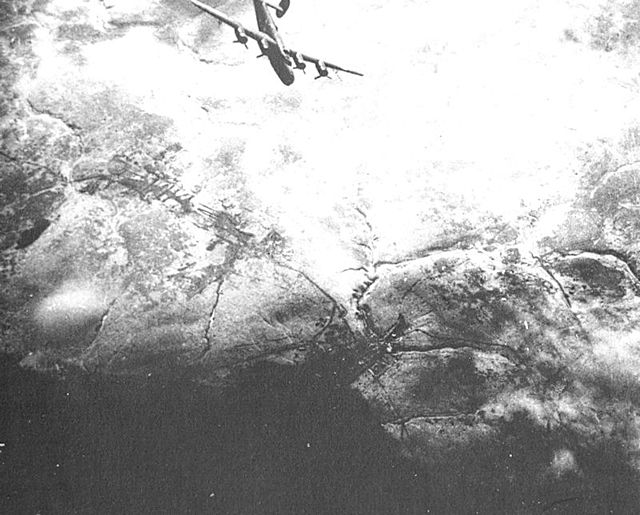 PACIFIC In the first step toward acquiring airfields in the Ellice Islands to support projected operations in the Marshalls and Gilberts, an advanced survey party moves onto Nanomea atoll. Tank landing ships LST-396 is sunk by explosion (believed to have been caused accidentally by own ship's force), en route to Barakoma, Solomons, 08°18'S, 156°55'E. Destroyer Abner Read (DD-526) is damaged by mine off Conquer Point, Kiska Island, Aleutians, 52°01'N, 177°26'E. Submarine Plunger (SS-179) damages Japanese merchant cargo ship Okuni Maru, 43°30'N, 140°30'E.
|
|



































































